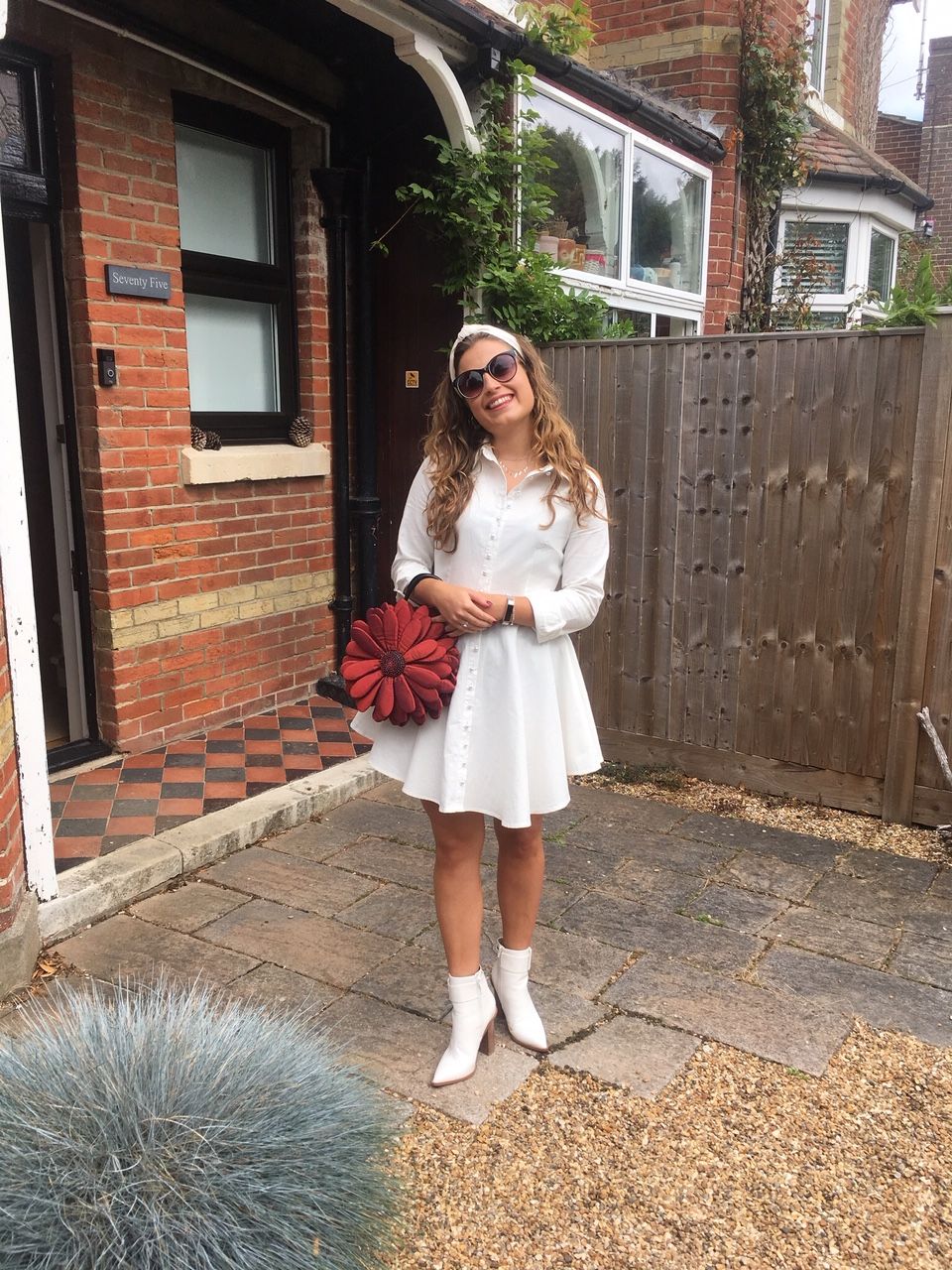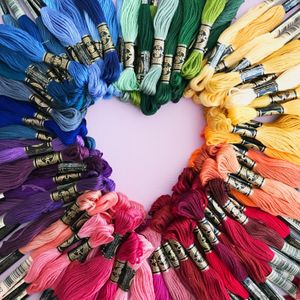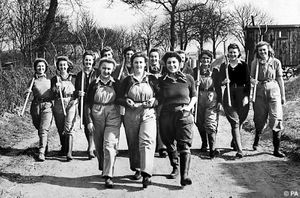About the Exhibition
The Hampshire Cultural Trust costume collection has been assembled over many years and includes garments that are over 250 years old.
From Jane Austen’s pelisse to popular fashion influences of recent years, these garments capture not only a moment in fashion history, but also the personal choices of individuals in their everyday lives.
Some of these wedding dresses were acquired from collectors, but many were donated by the families or descendants of the bride, often with a photograph or a story about the happy couple. These stories help us understand the social background of that period and the lives of the women who wore them.
Some garments were so fragile that they could not be displayed on a mannequin. However they are still of great historic interest and are used by researchers and designers, for example when developing costume ideas for stage and film productions. In some cases, particularly with headdresses, it is staggering that they have survived. Their existence is testament to the value placed on such special garments – perhaps the only items of clothing we will ever intentionally keep.
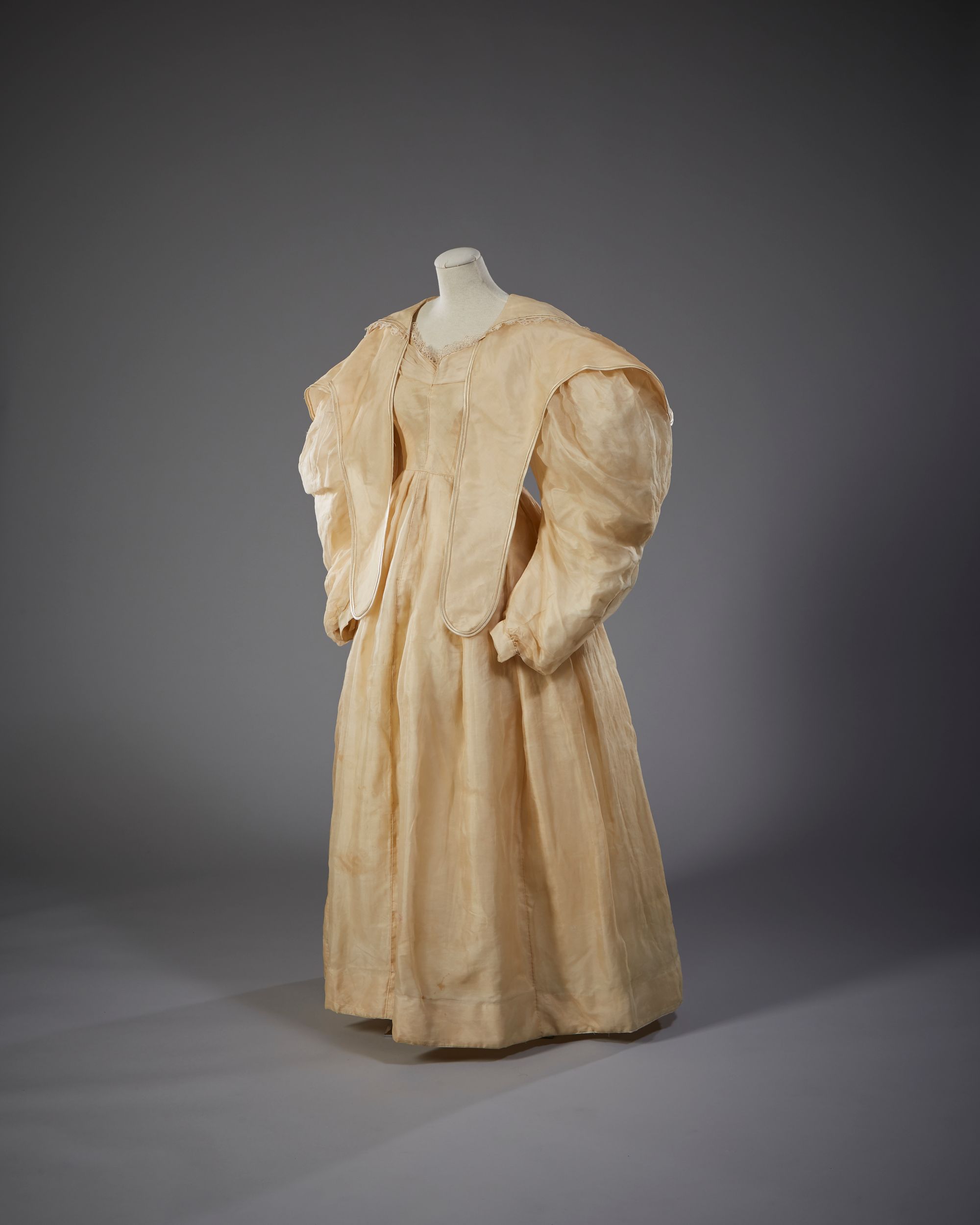
I Do!
The union of two people has been observed through a ceremony throughout the history of most civilised cultures. Wedding ceremonies were laden with superstition and religious significance.
These were special occasions for all levels of society, where participants tried to look their best. This was especially the case with the aristocracy and royalty, where weddings were viewed not only as a union of two people but also used as a political alliance between two houses and fortunes. Wedding parties were dressed with a degree of luxury befitting their status and the bride’s dress adorned with jewels or made of expensive cloth of gold and silver. Highly publicised weddings always attracted attention, and the wedding dress design was often copied. Today’s designers often draw inspiration from history, from classic antiquity and romantic middle ages, to opulent Victoriana and glamorous Hollywood.
In 2018, marking a year of Royal weddings, we searched our collection to bring a selection of dresses representing different eras and different styles, each with their own story to tell. This exhibition was displayed at The Gallery in Winchester Discovery Centre, Gosport Gallery and at the Willis Museum and Sainsbury Gallery.
The exhibition has now been digitalised for Culture on Call.
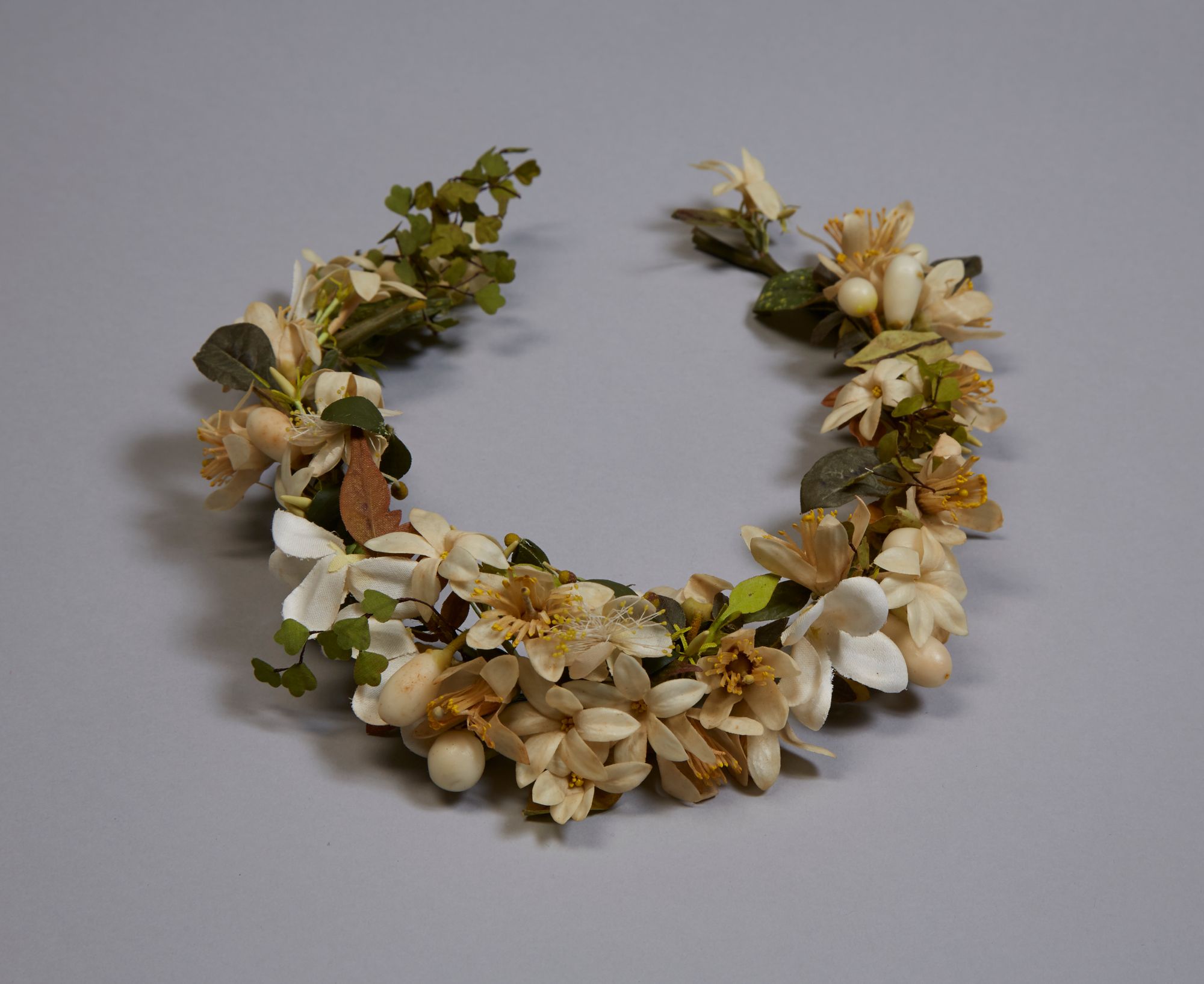
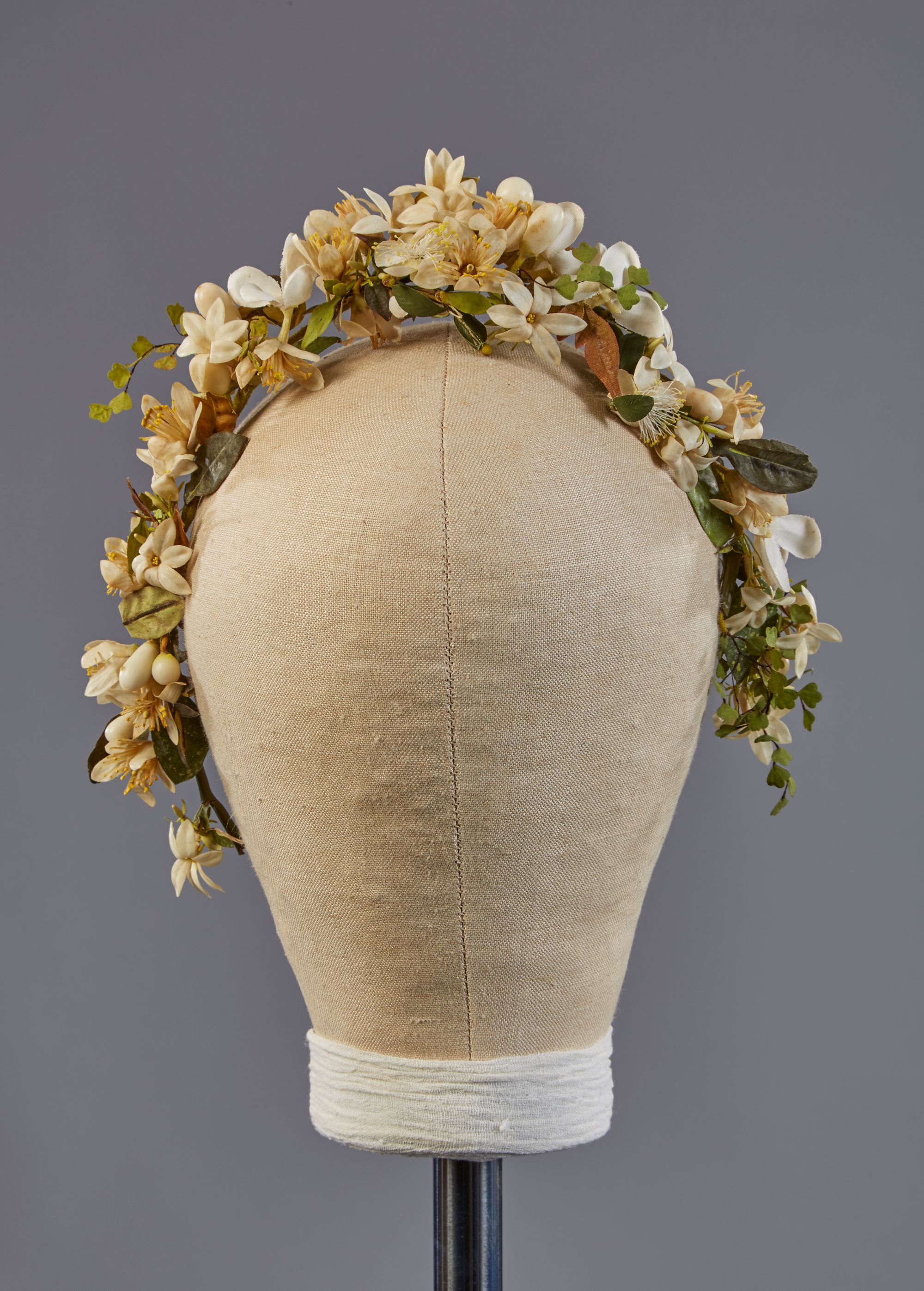
Part 1- Early and Victorian
The Dress
c.1770-75
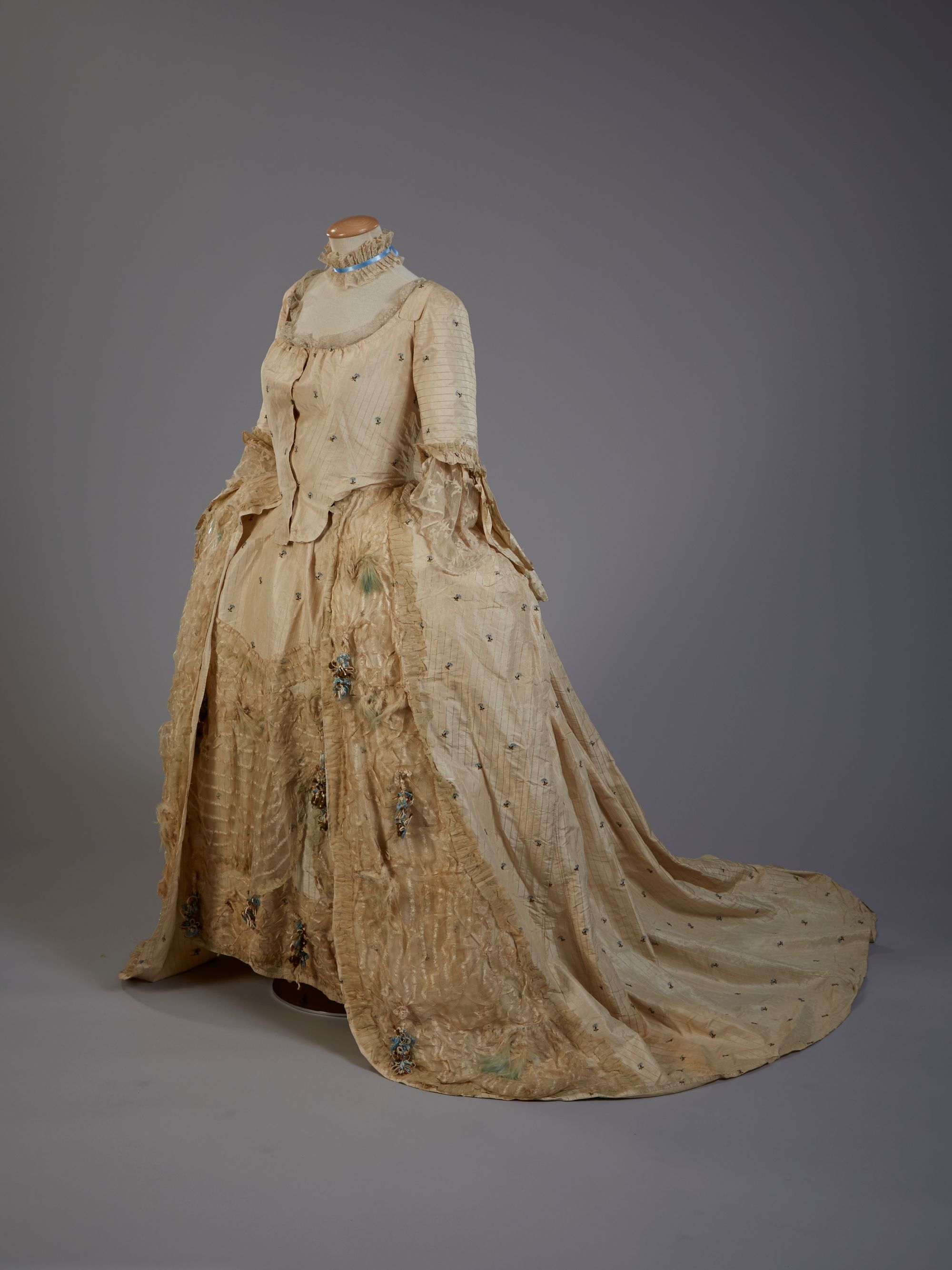
In the later part of the 18th century fashion was reflected not only by the pattern and choice of fabric, but also by the style and quality of the trimmings. The women of the gentry and the middle classes appear to have preferred light-coloured silks in pastel colours, patterned with flowers. In aristocratic circles, white and silver cloth was very much in fashion.
This French-inspired gown consisting of an open robe and matching petticoat with a sack-back and train, is made of cream silk brocaded taffeta, quite possibly made by Spitalfields silk weavers in London.
The floral motif of the gown is matched by lavish trimmings of feather sprays and tassels formed around light wood and wire, creating floral forms. The sleeve cuffs, weighted down with lead, would have been worn with lace ruffles, and the bodice, which has an integral stomacher, is lined with fine linen.
This gown is believed to be the wedding gown of the donor’s great-great-great aunt and it probably survived alterations due to its sentimental value or because it was simply stored and forgotten about.
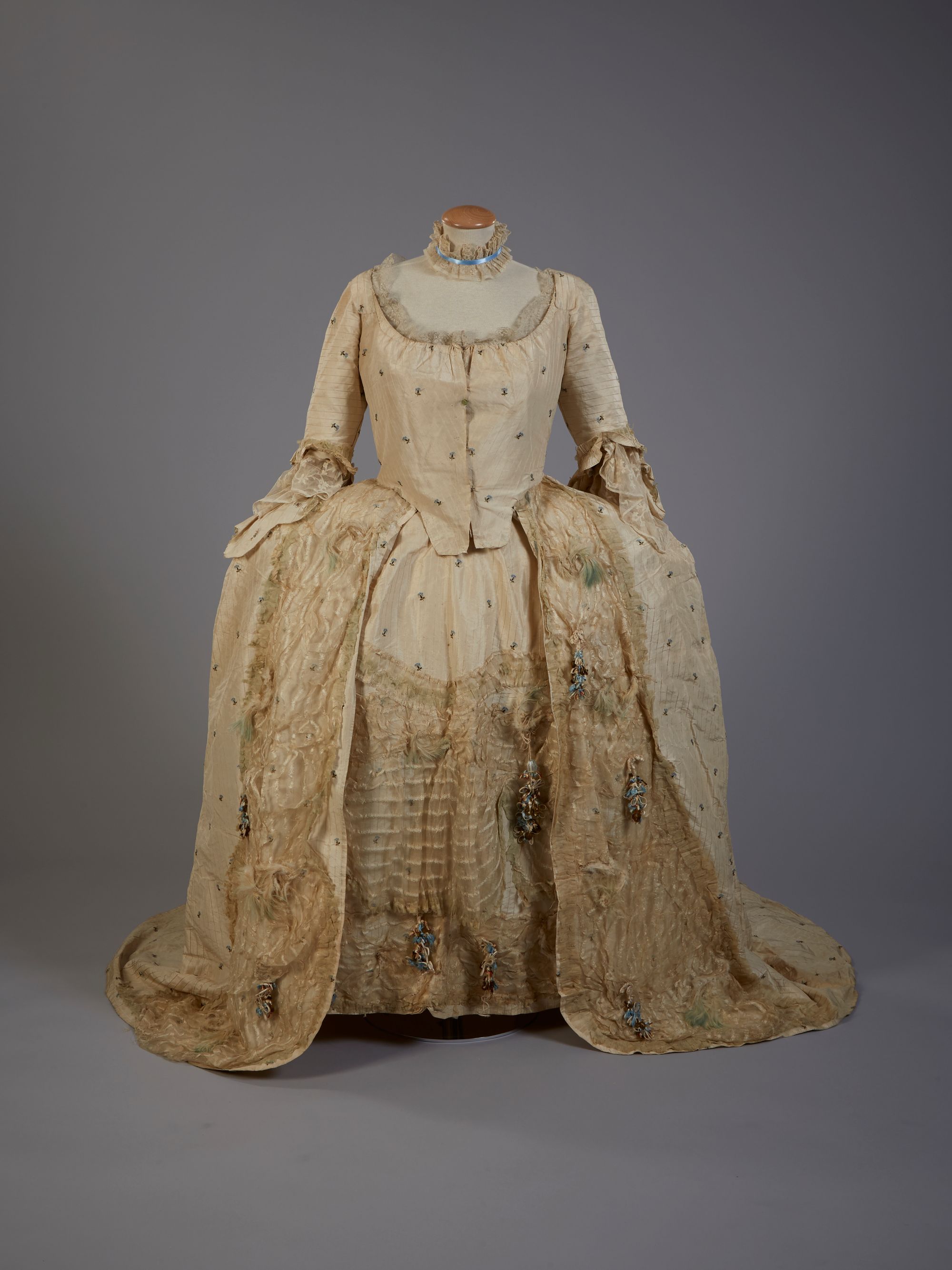
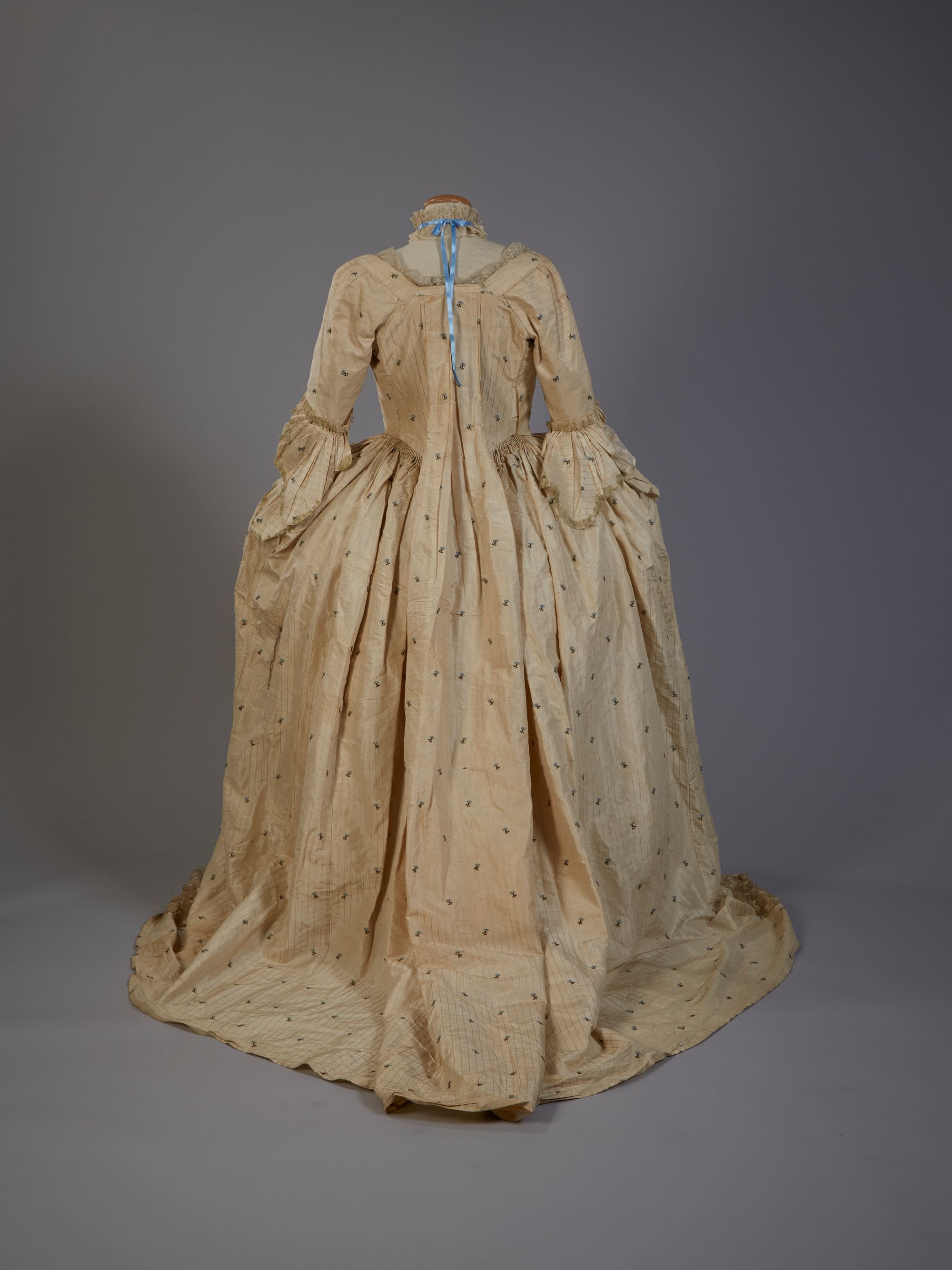
The Dress
c. 1805
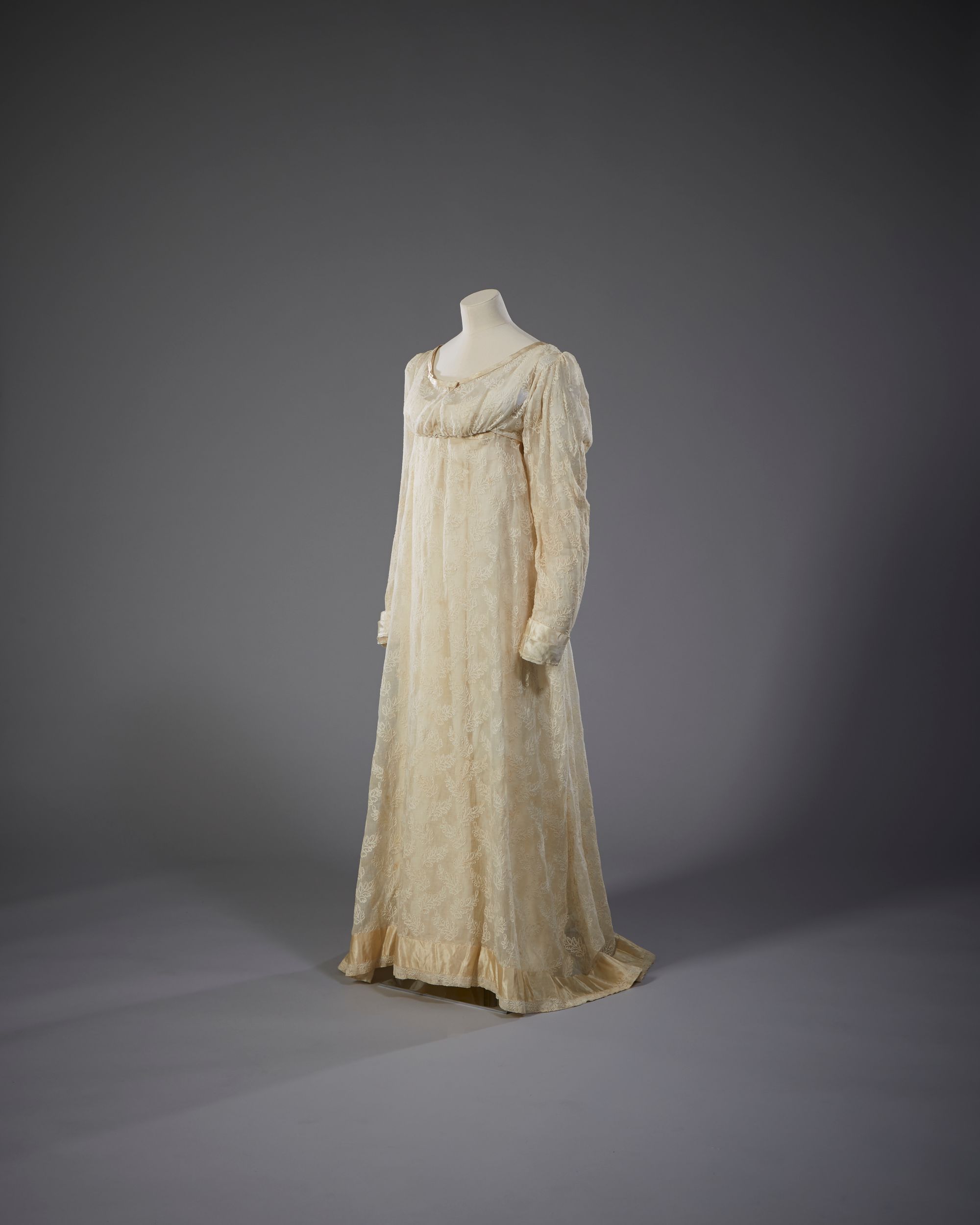
By 1805 the lack of precious jewellery and elaborate trimmings reflected the shift towards a more informal, less ostentatious aesthetic, with the white and silver fabrics being replaced by white on its own. Waistlines began to rise, sleeves became shorter, without lace ruffles, and the silhouette became slimmer.
Fine, sheer muslin was imported from India, and very light silks and fine cotton were also popular. Machine-made embroidered net was a fashionable alternative to muslin. These fabrics were ideal for the new fashions that were influenced by styles depicted on ancient Greek and Roman artefacts, a fashion that was imported from France.
This cream leno muslin with tambour work dress with simple silk trimmings might have been worn with a lace veil to distinguish it from an evening dress. The underdress would have been made of silk, perhaps of a very pale colour, to show up the decorative patterns on the fabric.
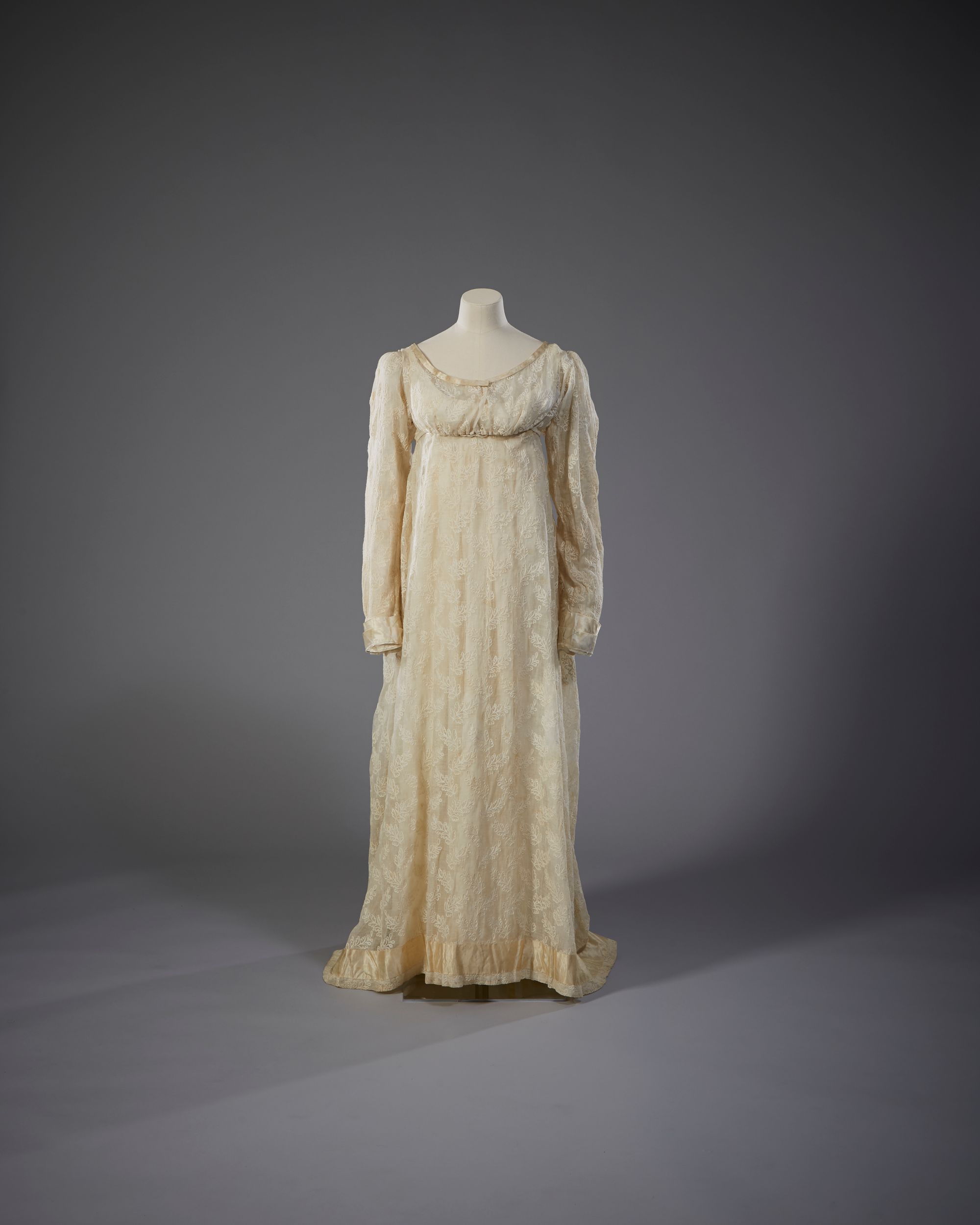
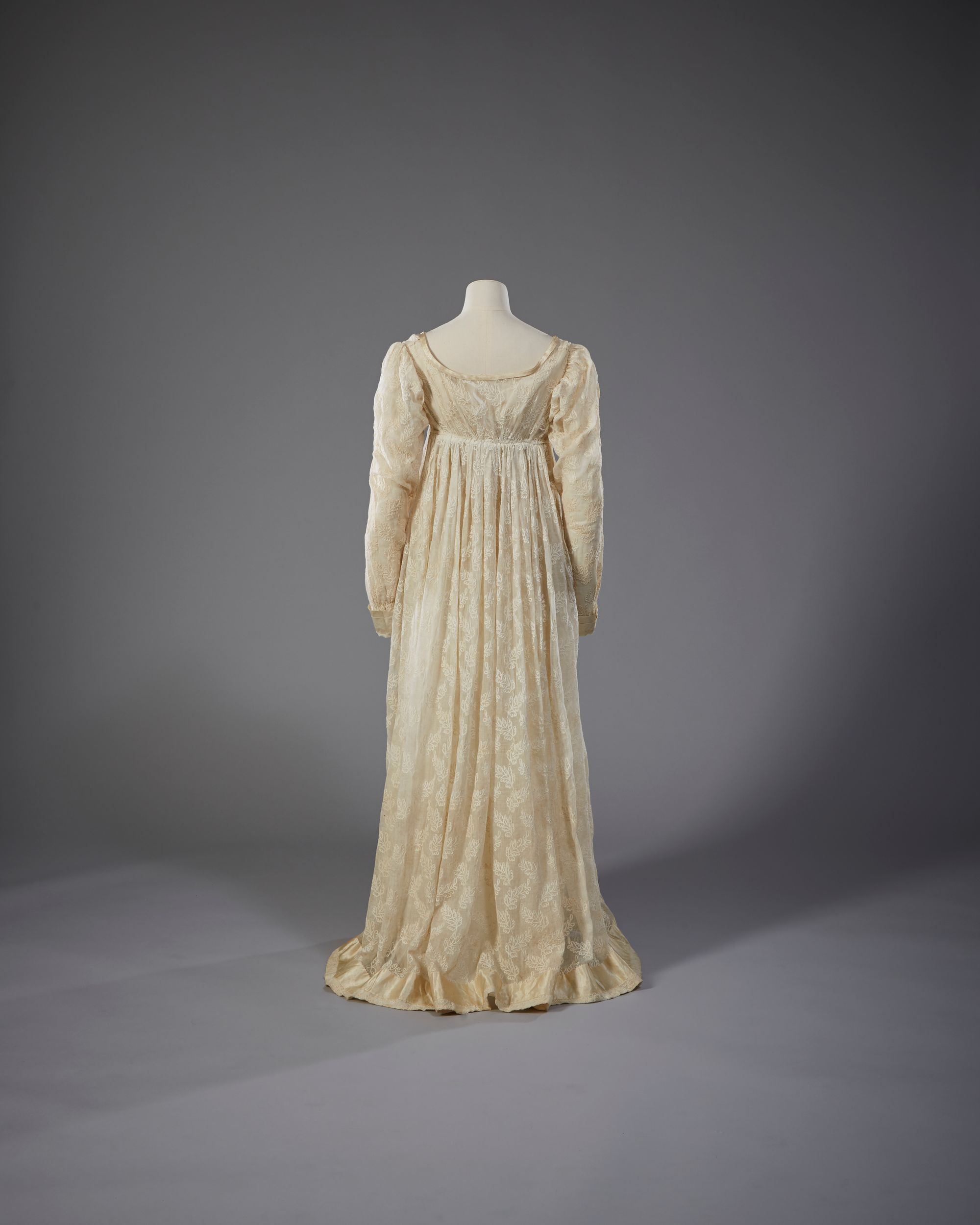
The Dress
c.1830-35
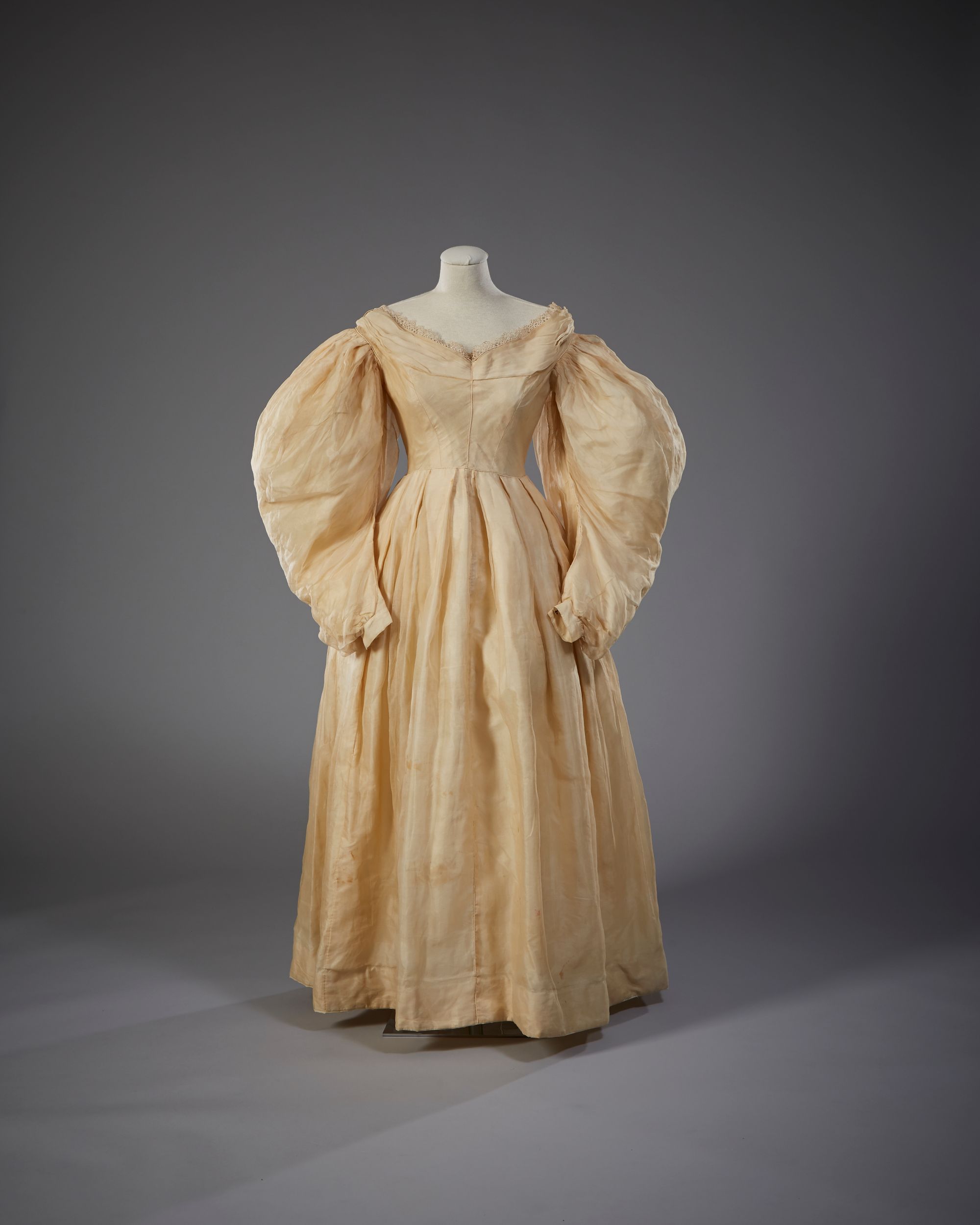
In early 1830’s, fashionable wedding dresses tended to have elaborate trimmings and swathes of expensive lace draped around the collar, although most of the surviving wedding dresses of the period are considerably simpler.
The shoulders of these fashionable dresses have started to slip lower and the sleeves are now huge puffed extravaganzas, often called ‘imbecile’ due to their impracticality. The waistline is once again at its natural place and simple corsets emphasise the ‘ideal’ female form.
The owner of this dress is unknown to us but from the quality of the fabrics and the styling of the decorations we can presume that was worn by a lady from a family with some disposable income. A loose 'fichur' modesty piece tucked around the upper bodice would reveal details of the lace that finishes the pleated neckline.
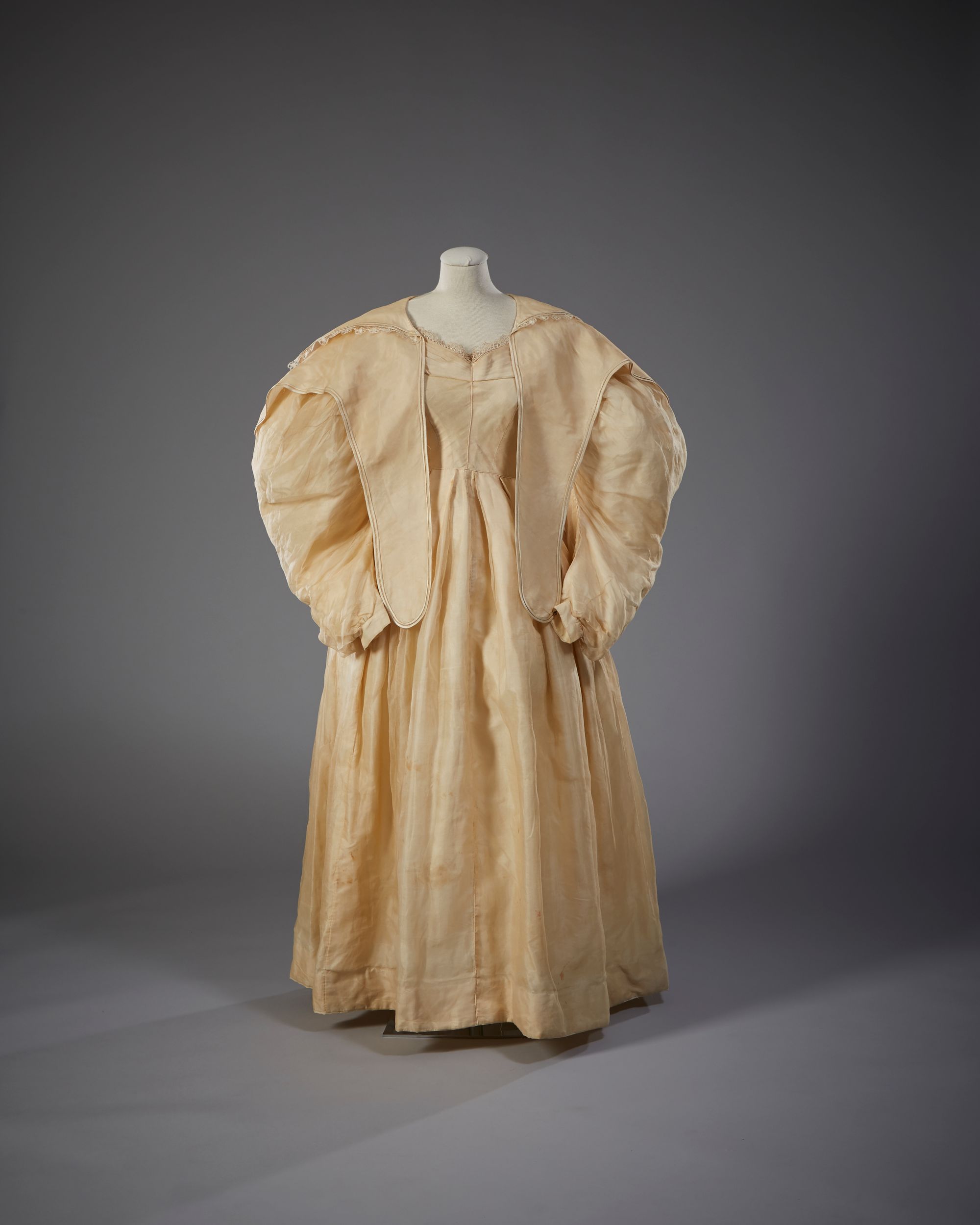
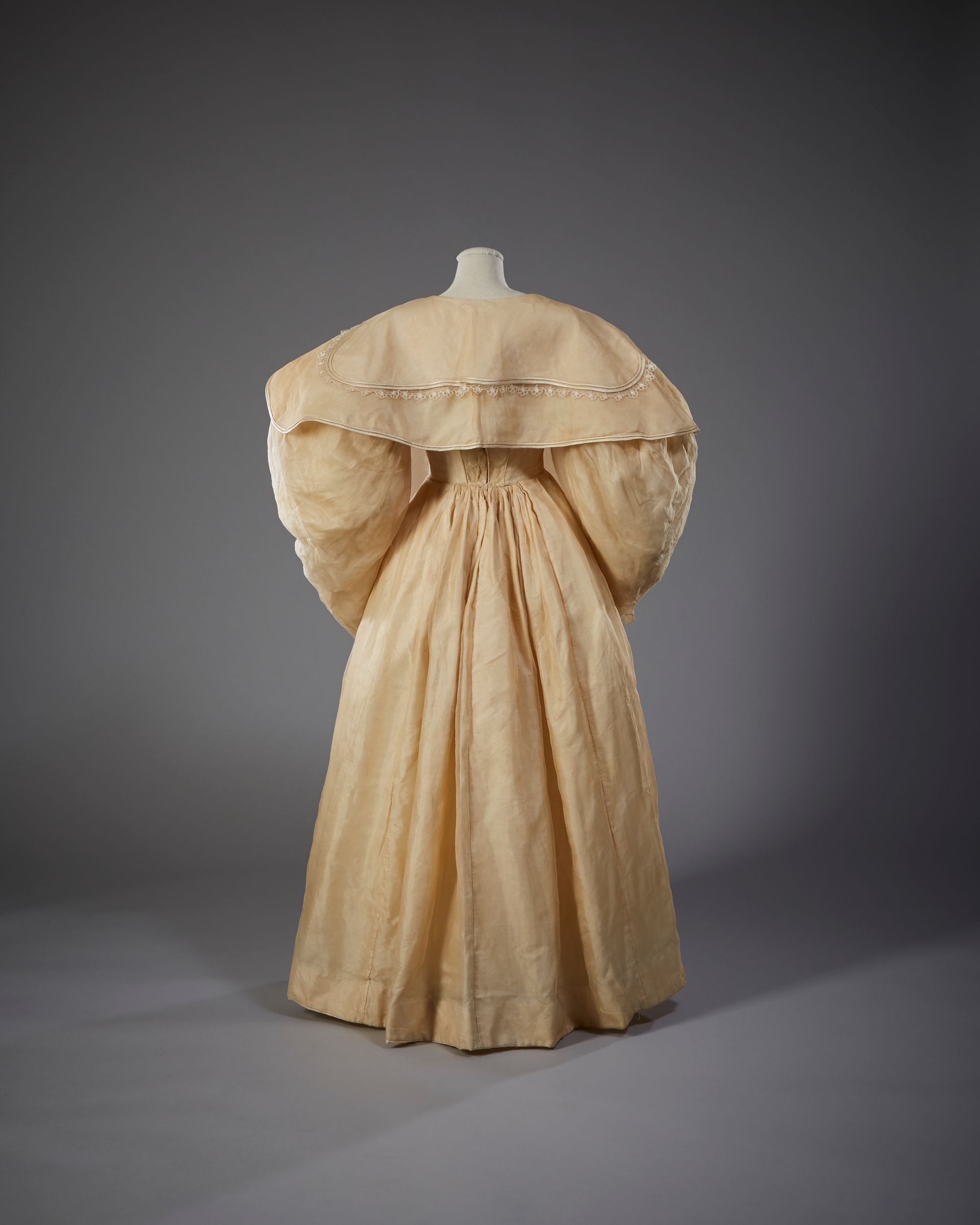
The Dress
14 August 1838
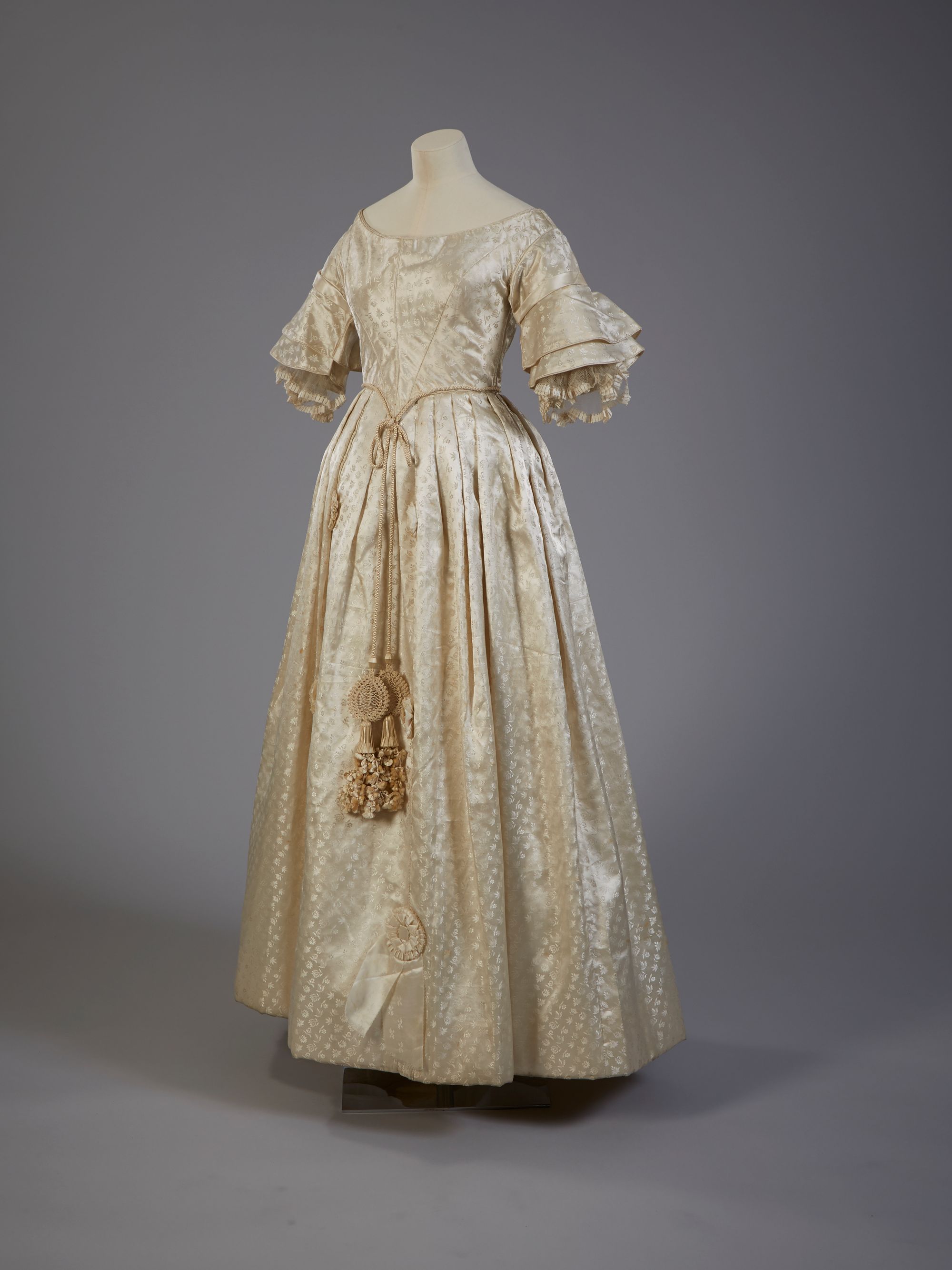
On 10 February 1840 Queen Victoria married Prince Albert in a white silk satin dress decorated with orange blossoms and wearing a lace veil. This transformed the white wedding dress from a fashionable choice to an instant ‘tradition’.
The design of this 1838 dress is moving towards the style of Victoria’s wedding dress with the exaggerated Medici point at the front of the corseted bodice, lace frills and rosettes, a veil and silk cord with elaborate tassels. The sleeves of the dress are less full and with the elongated bodice, creates a slimmer, more elegant figure.
The floral pattern of the dress, in the same colour but in a different weave, creates a shimmering effect. The same fabric has been used for the accessories that accompanied the dress - shoes, a small pouch and a pair of longer undersleeves.
Wedding dresses were used not only during the ceremony but also, with the addition of accessories, during the presentation of the bride to a wider social circle at tea parties, dances or the opera.
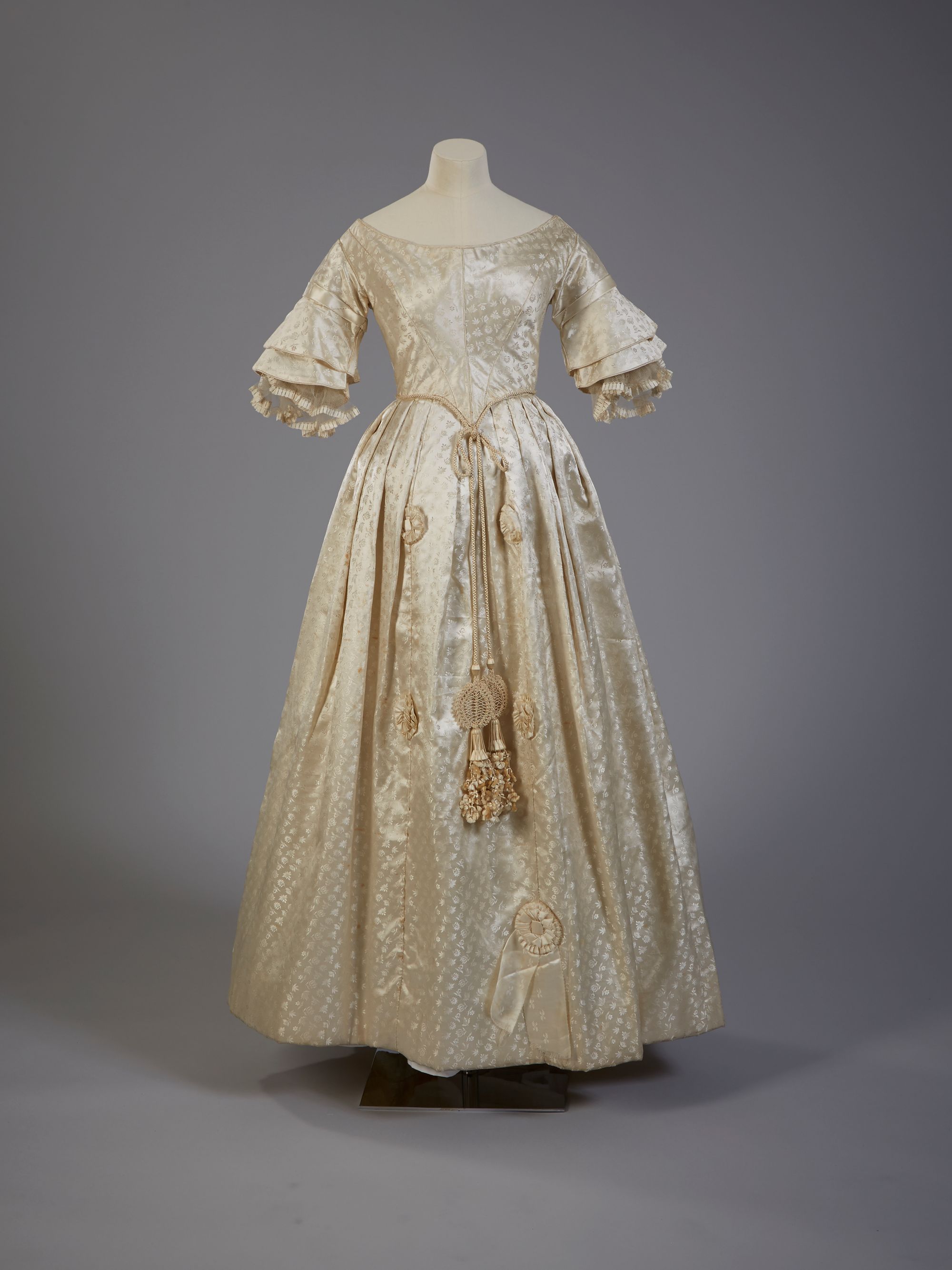
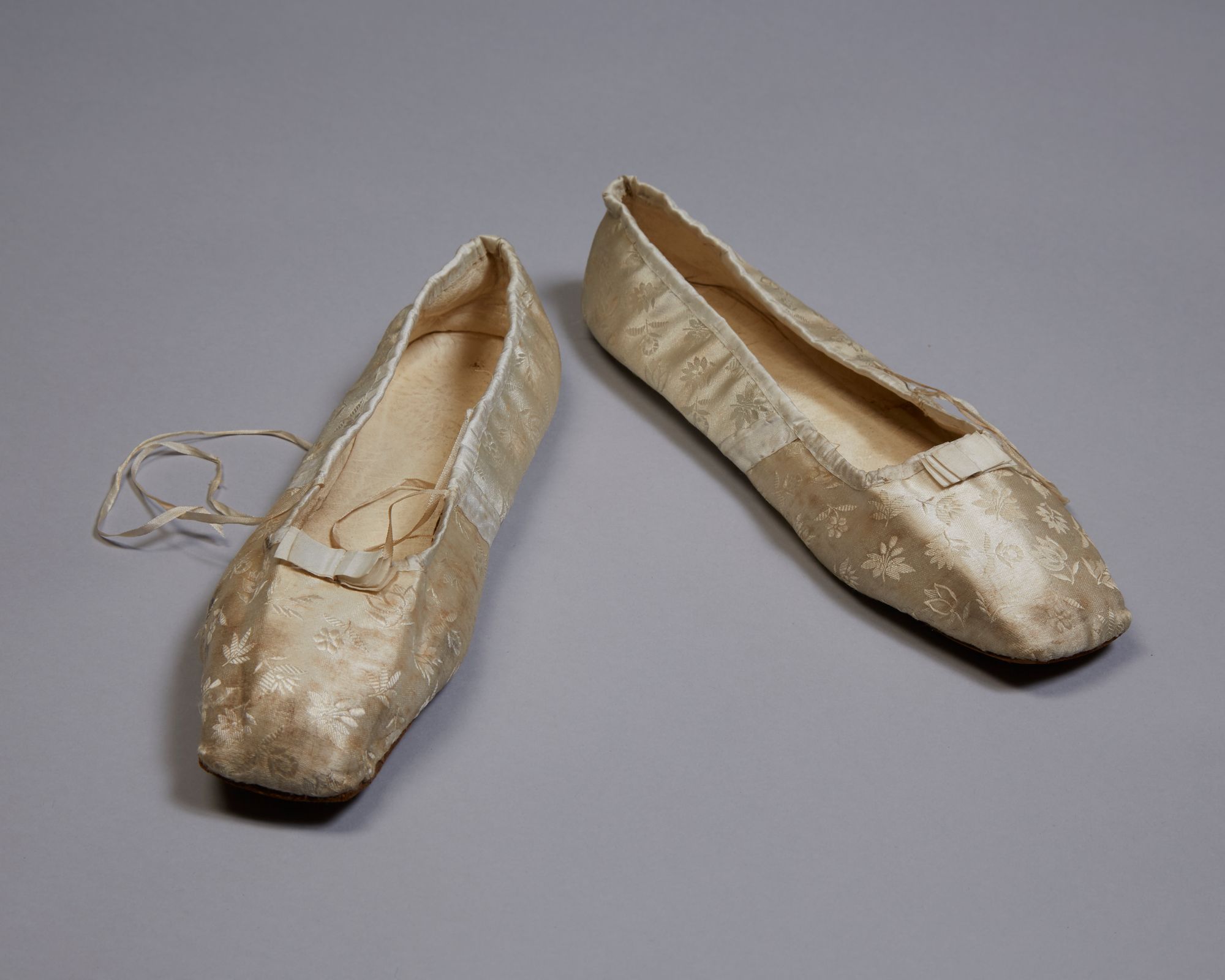
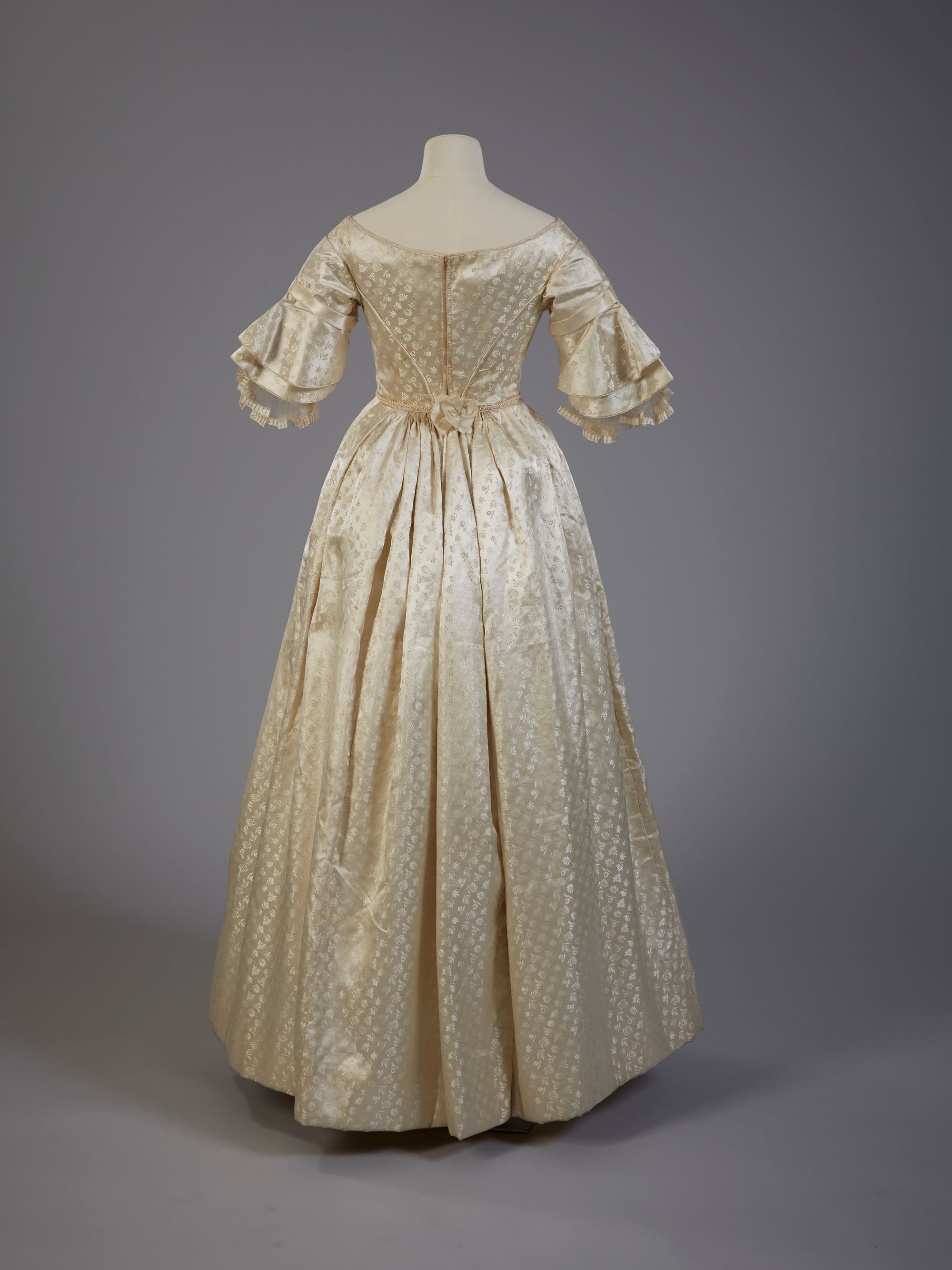
The Dress
c. 1840-1850
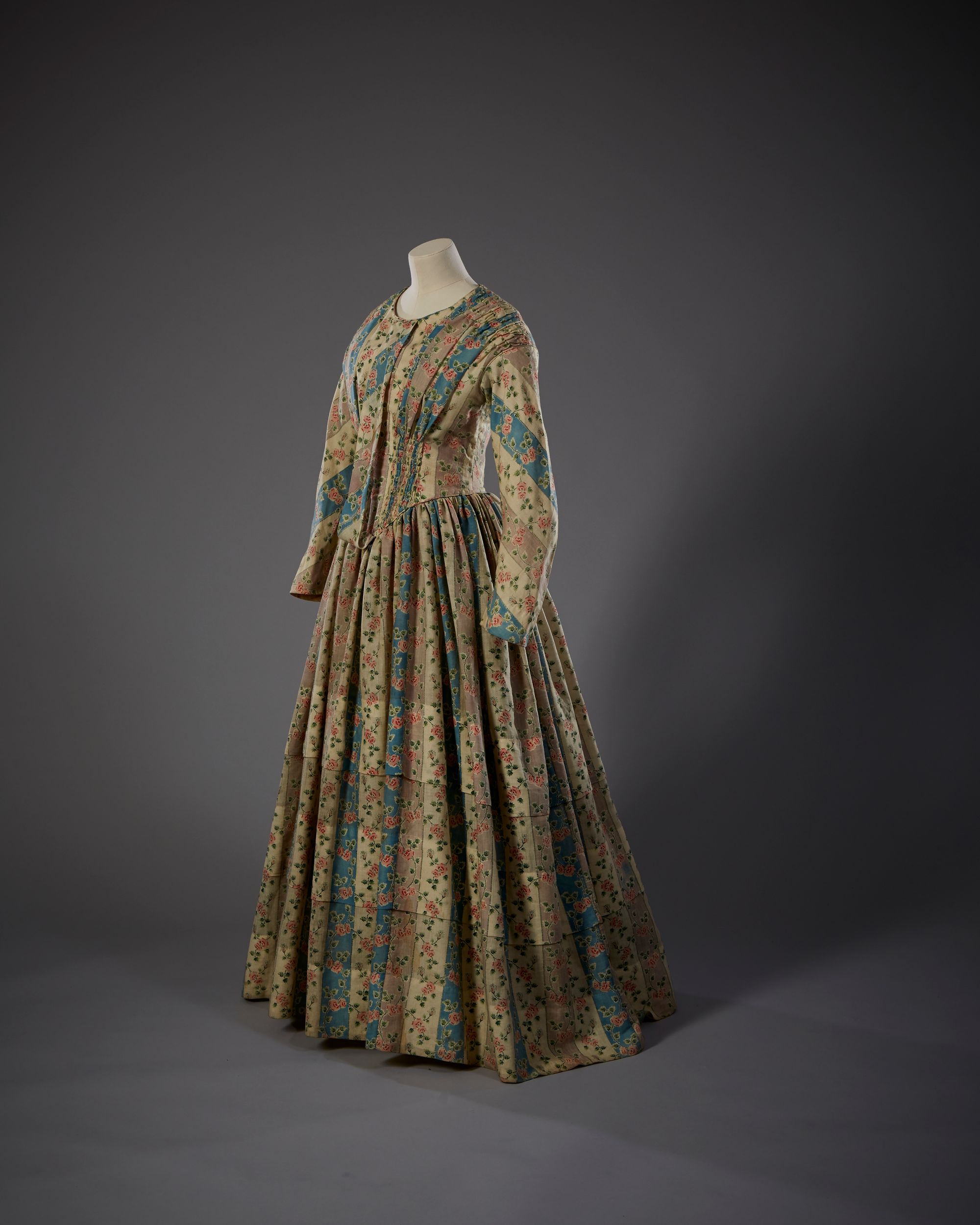
By the mid-19th century the white dress, veil and orange blossom wreath had become a tradition followed by most Victorian brides. However, this was only true for the middle and aristocratic classes who could afford to follow fashion trends, with expensive silks and satin.
Families with lower income or in less accessible parts of the country had to be more practical. New block printing techniques made the production of cheerfully patterned fabrics easier, faster and therefore cheaper. Cloth for a wedding dress could have been bought from a local merchant or traveling peddlers that brought their goods to fairs and markets in more rural locations. Fashion plates would inspire but would be toned down, as these dresses had to withstand the test of time while also serving as ‘Sunday best’.
The maker of this dress has taken great care to produce a garment that is fashionable, referencing the pointed bodice and the layered skirt, adorned with the gauging detailing around the waist area and the shoulders. Stripes and flowers were a popular design at the time and the combination makes a dress very suitable for a country bride.
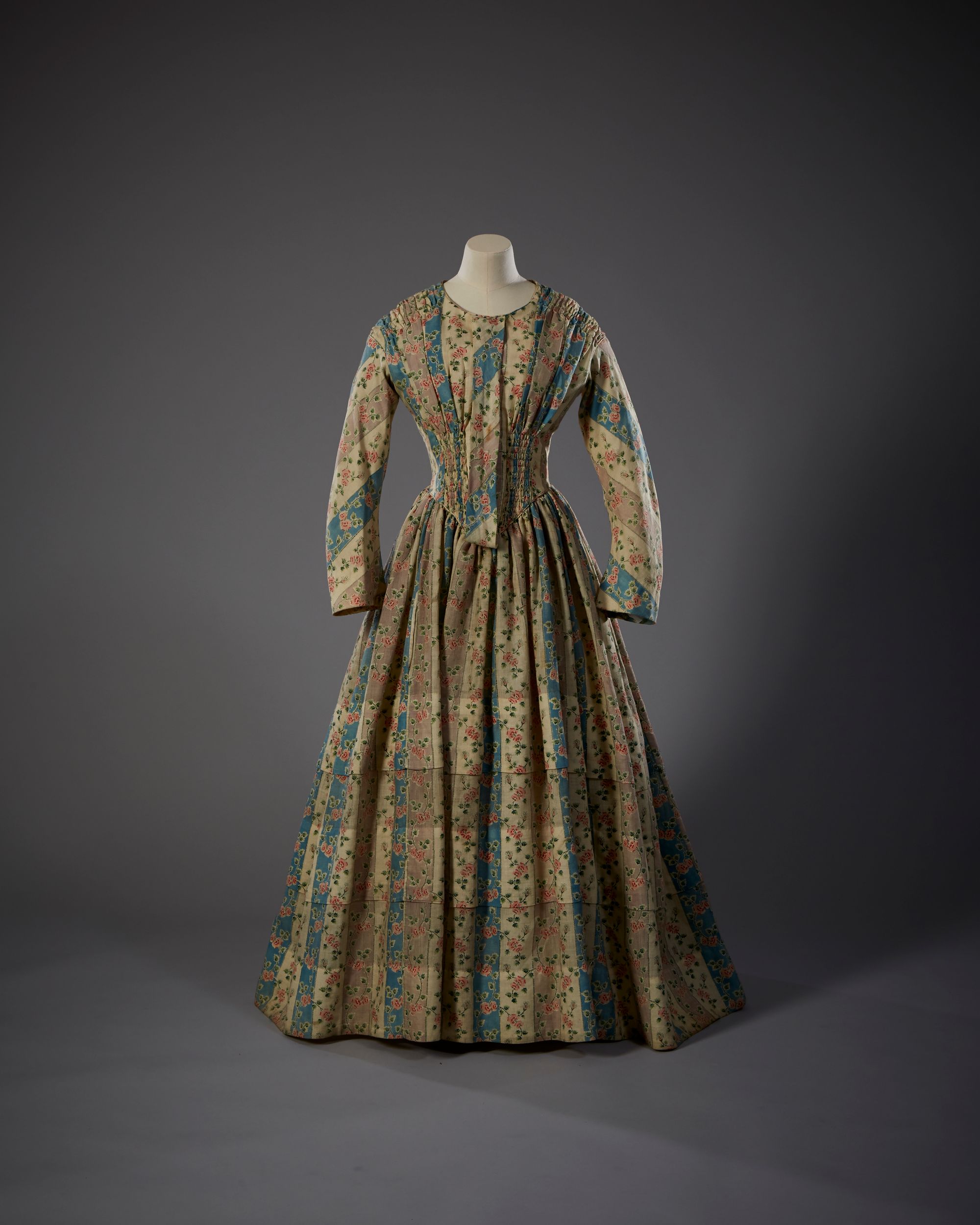
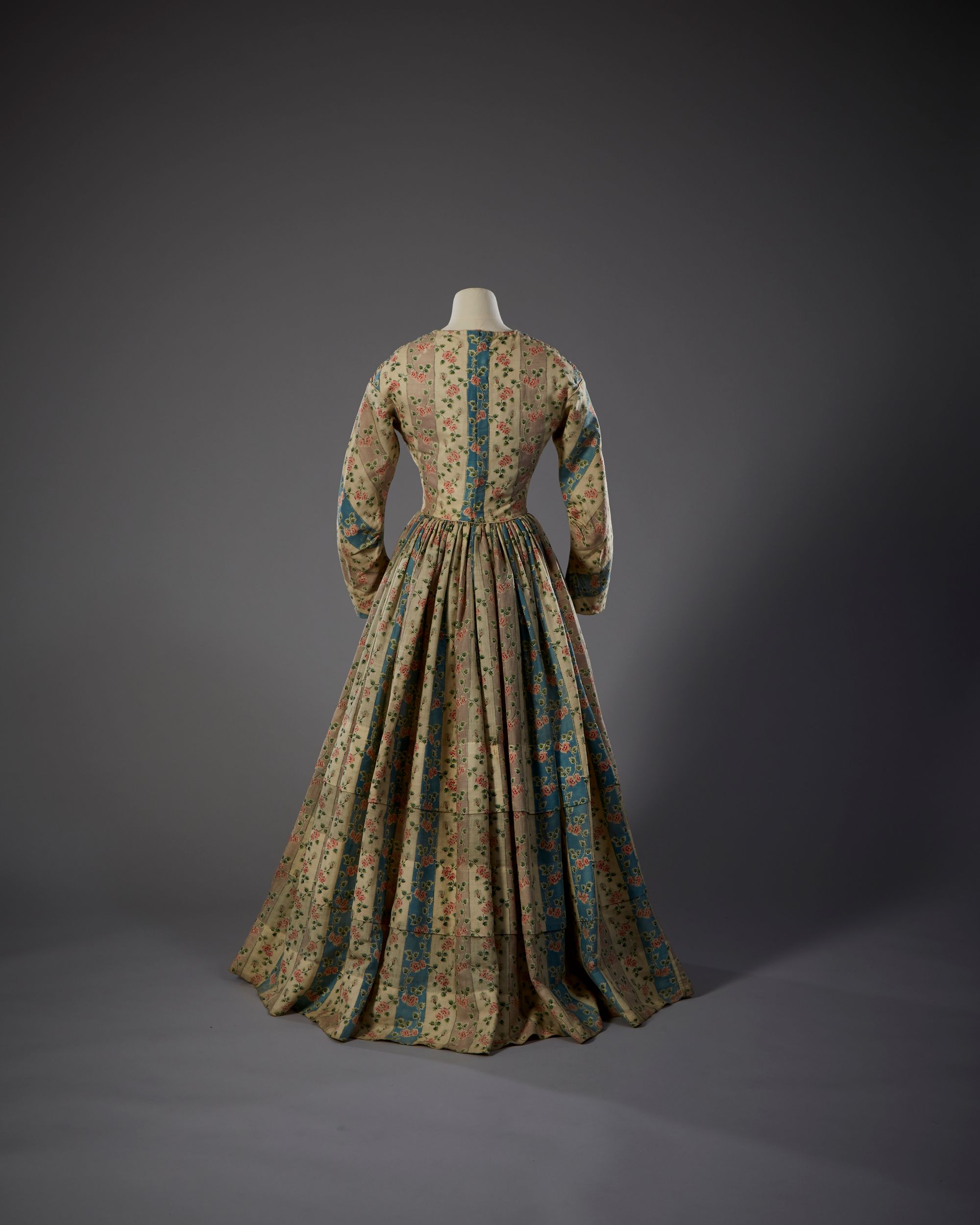
The Dress
c. 1873
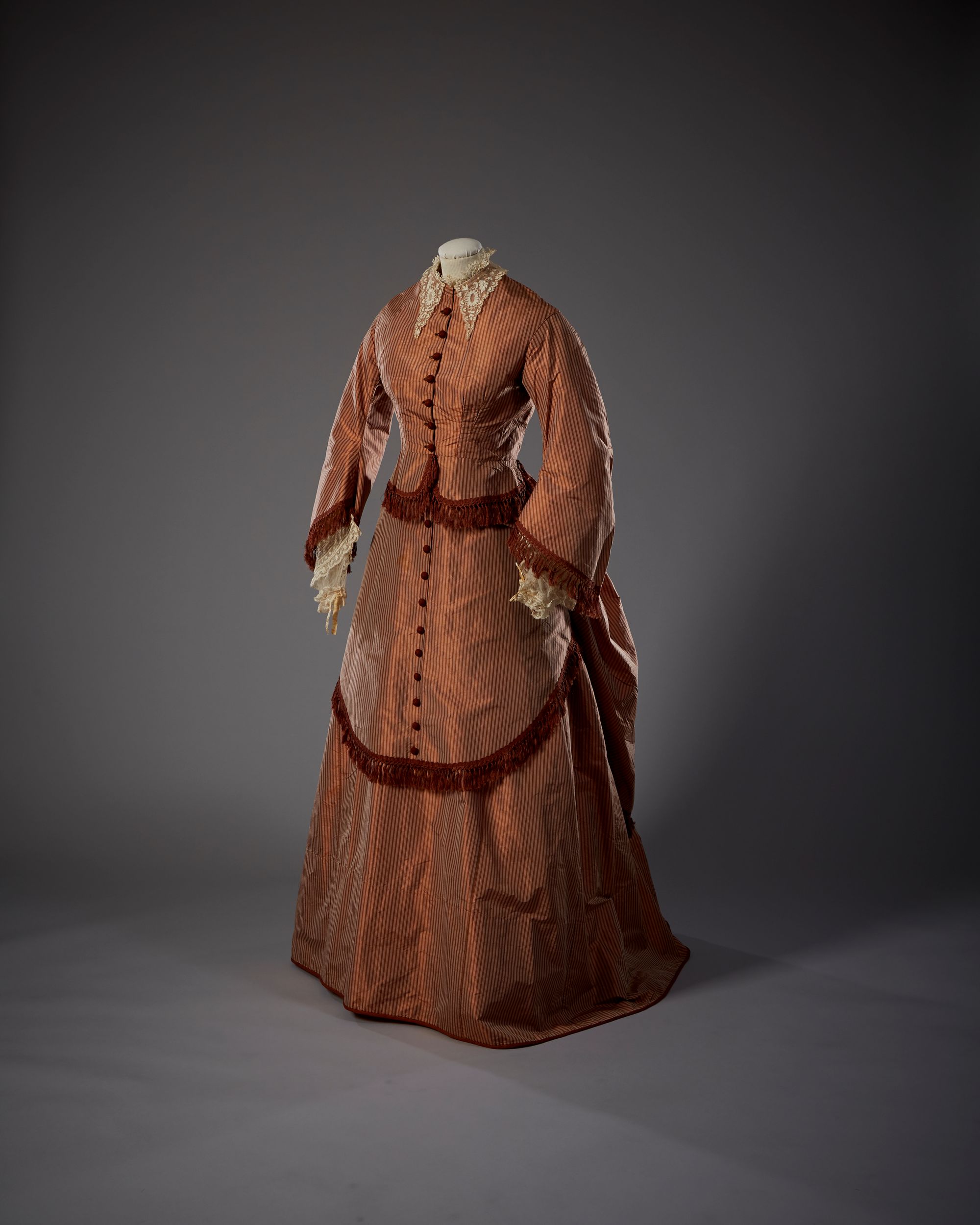
The second half of the 19th century saw the exaggeration of the crinoline, so often ridiculed in the national press as the most impractical of fashions, being slowly replaced by a more slender and slim outline. As the amount of fabric used did not decrease, the appearance of loops and gatherings on the sides and at the back led to the invention of the bustle which held the skirt out at the back, just below the natural waist.
There was no shortage of royal weddings as Victoria’s nine children came of age and made strong links with other European royal families through marriage. These weddings were highly publicised as the alliances formed were of national importance. The tradition of the white wedding dress continued and was followed by the princesses and ladies of high society. However the invention of aniline dyes in the middle of the 19th century was responsible for some really startlingly colourful wedding dresses.
This wedding outfit, comprising of bodice, skirt and bustle of bronze striped shot silk taffeta, represents the latest in fashionable style. It incorporates fringing of brown silk, a high round neck with lace frill and tamboured net collar and flared or pagoda sleeves with net 'engagements'.
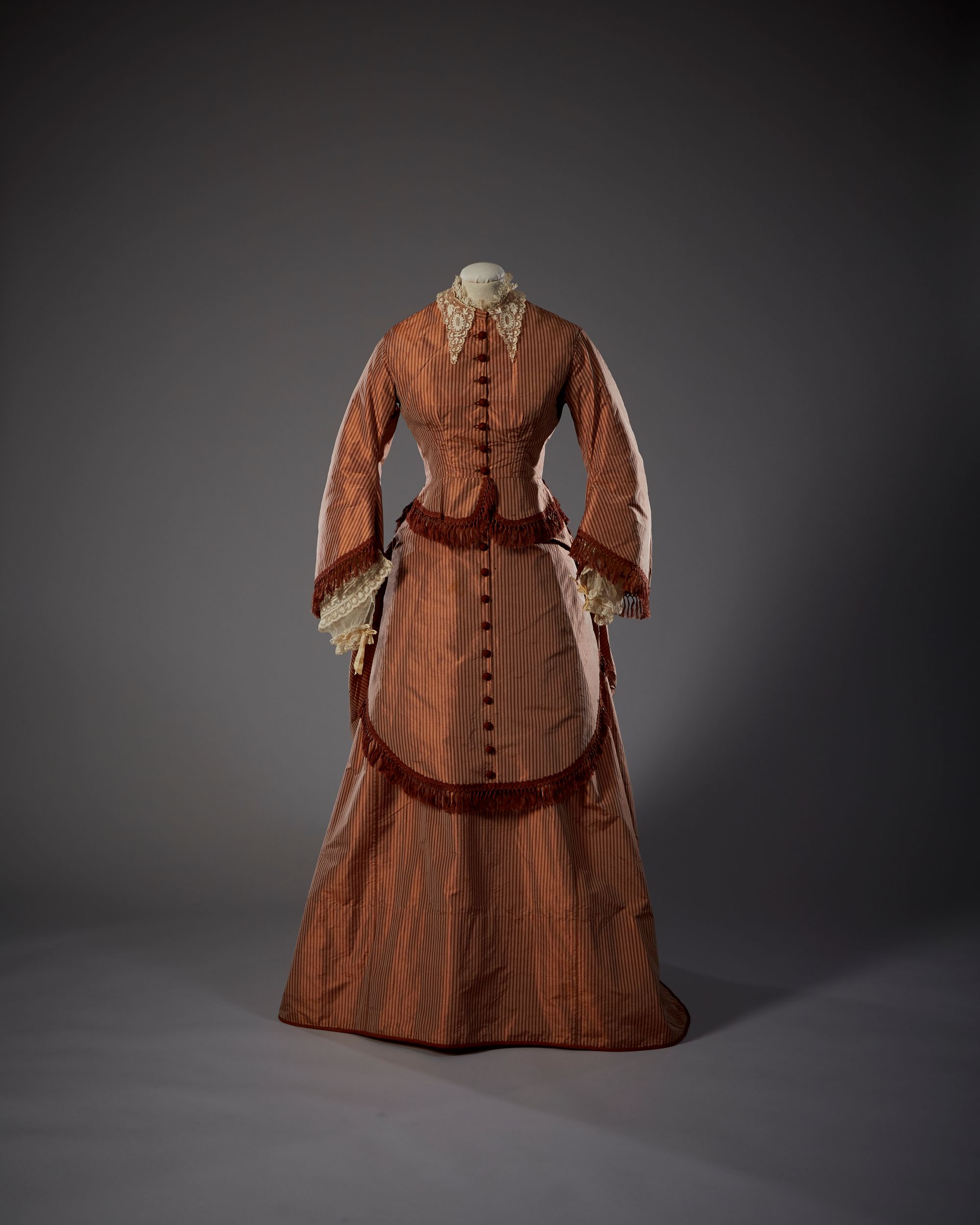
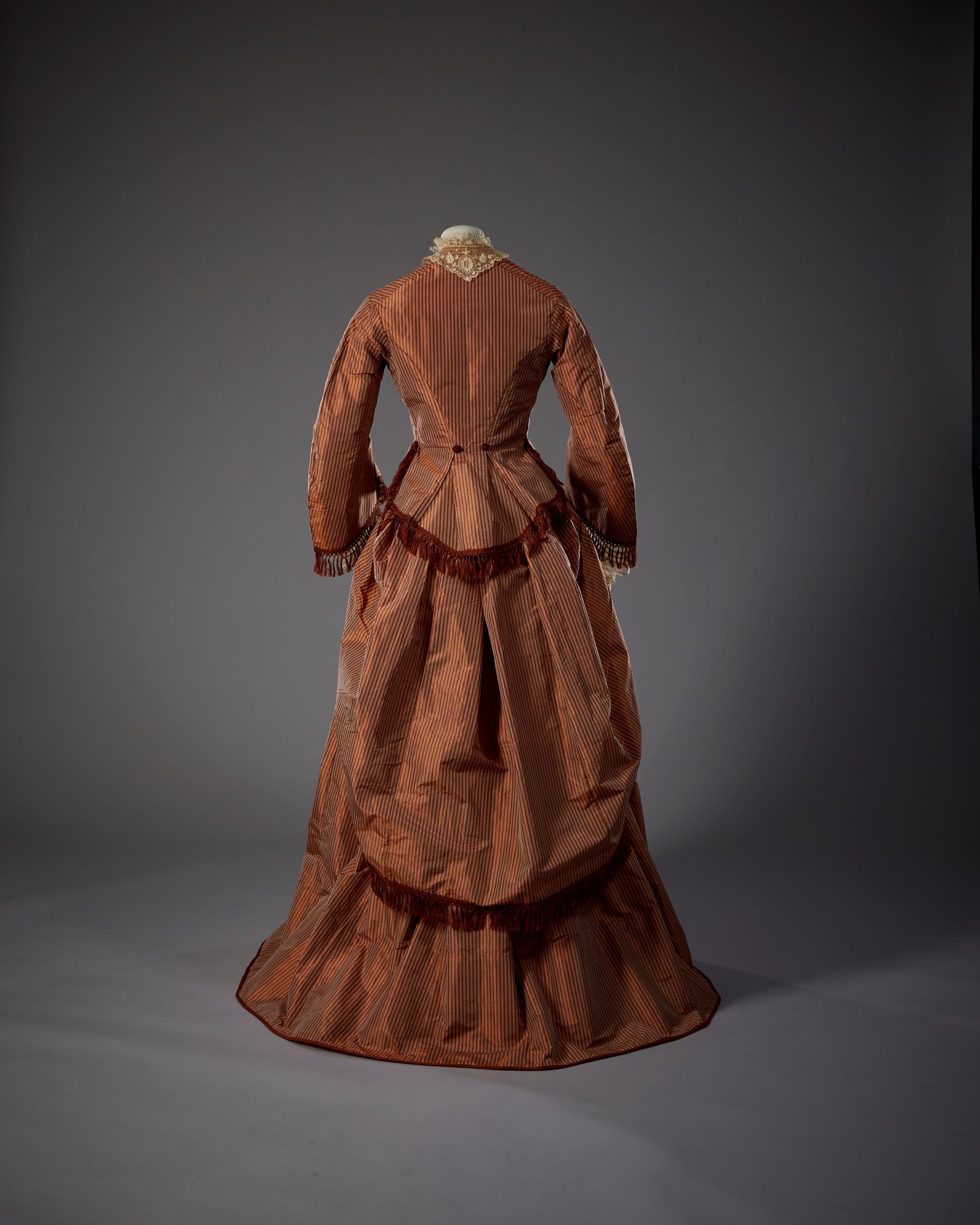
The Dress
c. 1879
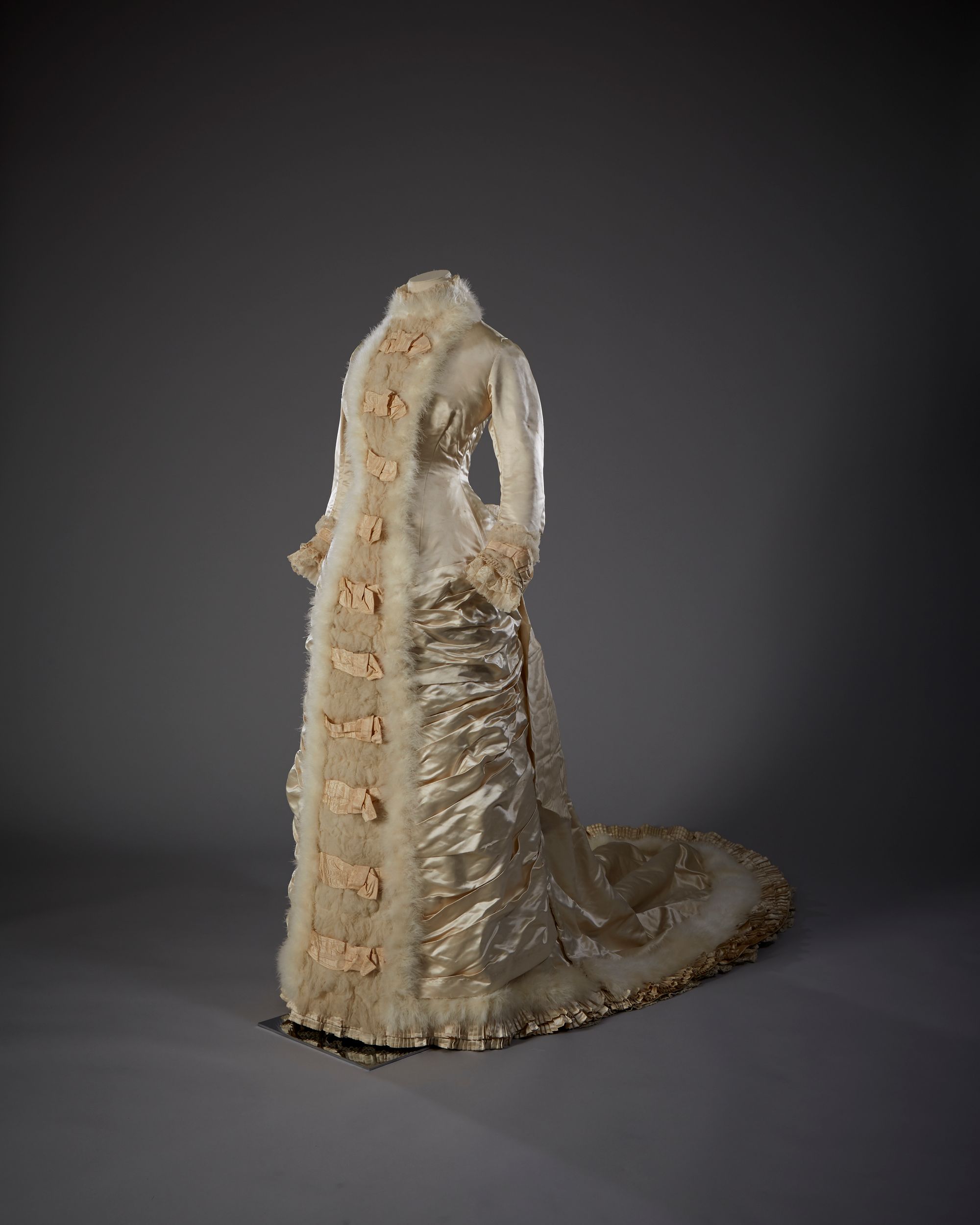
The ‘princess line’ cut came into vogue in the late 1870’s, creating a line under the bust instead of around the waist. Long, vertical panels, without the use of a horizontal join, produced tightly fitted dresses made as one piece, rather than a separate bodice and skirt. With the aim of producing elongated, elegant, column-like forms, whalebone corsets and sometimes even leg straps restricted movement. Waists were as small as 17” or 43 cm.
Lace, net, silk ribbons and swansdown create a very striking effect for this winter bride. The horizontal gathered silk panels are contrasted by the tightly pleated hem decoration indicative of the period, and the loosely attached net of the front panel is effectively restricted by silk taffeta ties. A moiré silk oversized bow offsets the long train decorated with a double layer of tight pleats and swansdown.
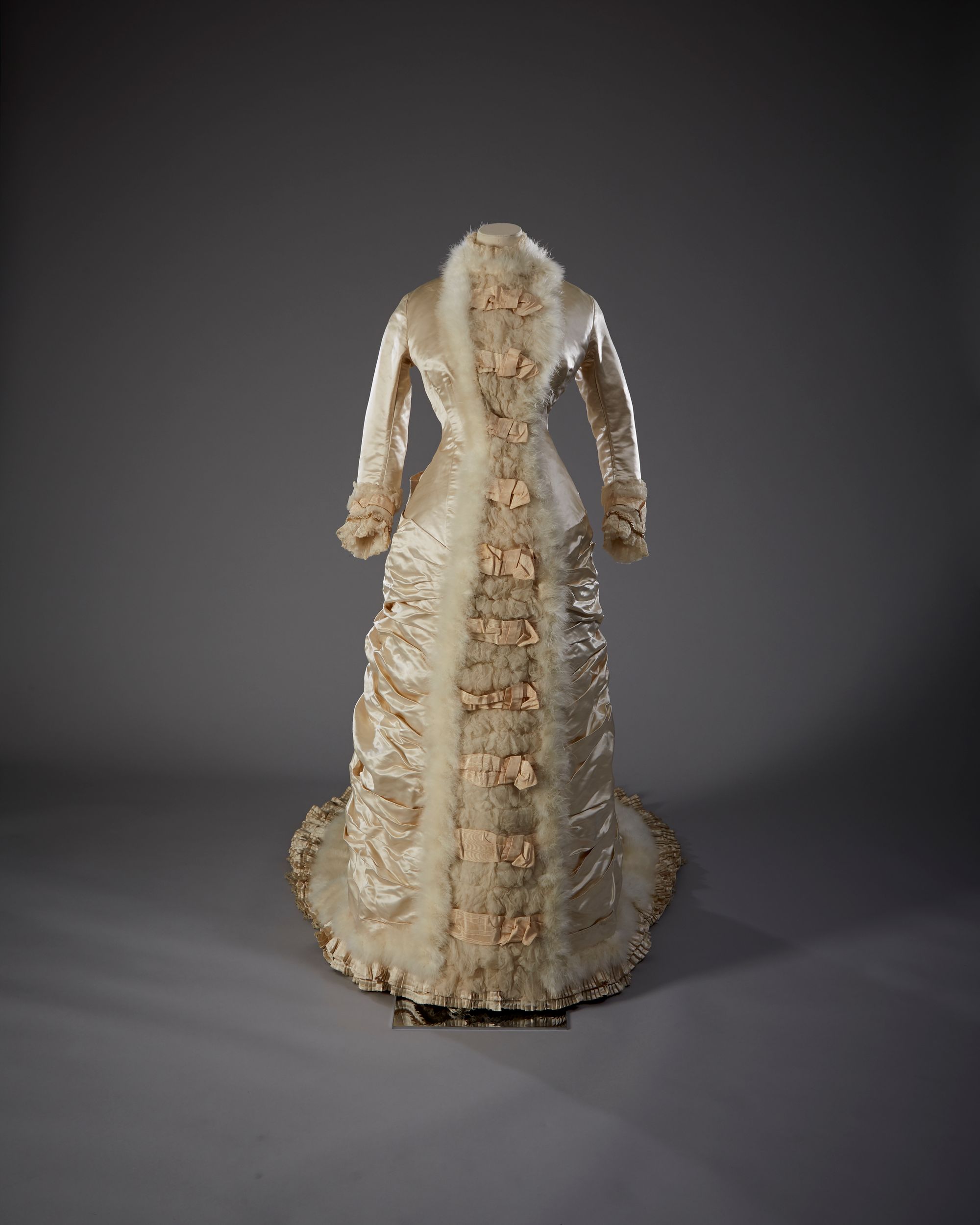
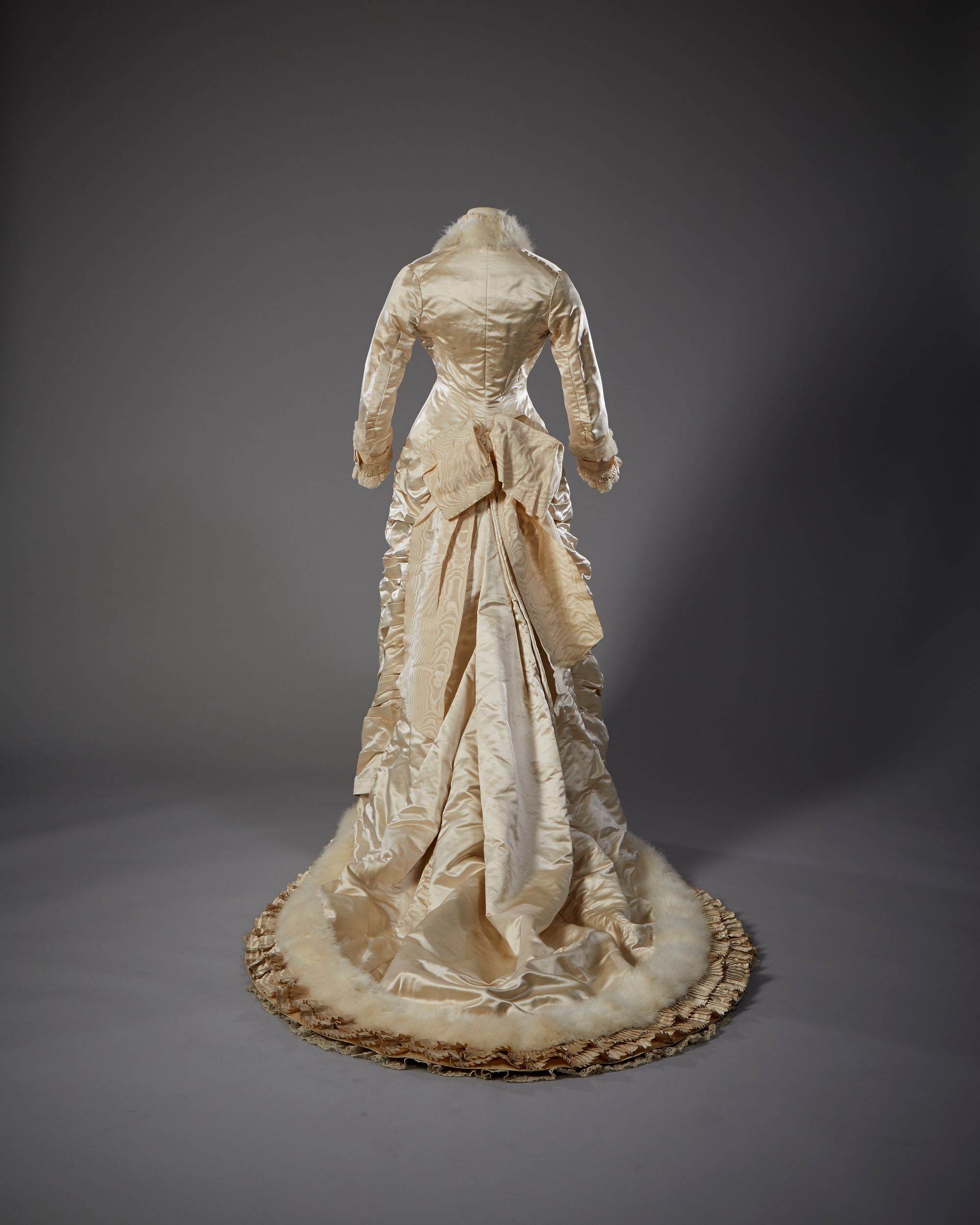
The Dress
c. 1880
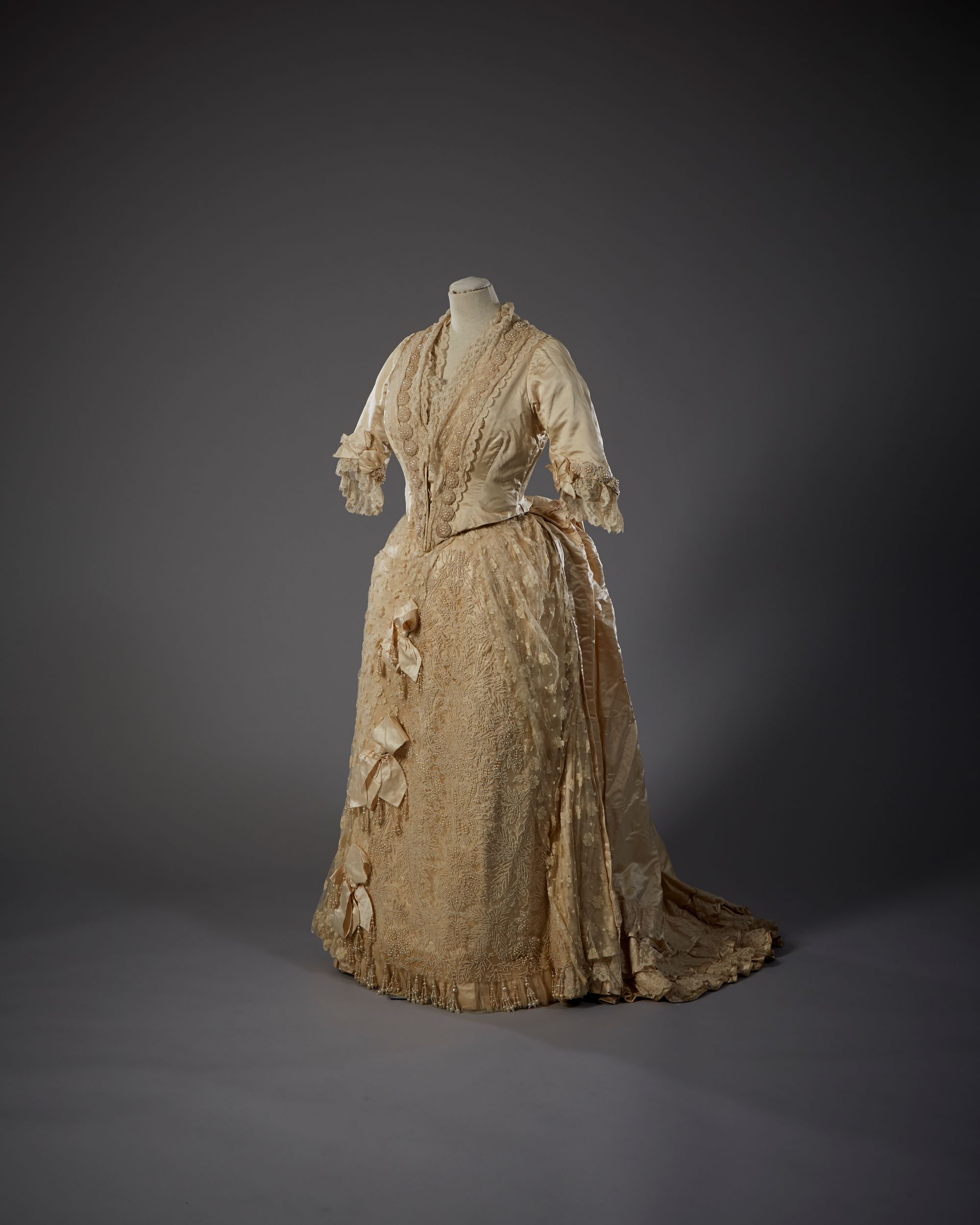
By the 1880's, symmetry and structure gave way to elaborate, over the top decorations, asymmetrical designs and the further exaggeration of the bustle. Swathes of machine lace with elaborate, usually floral motifs, are used to accentuate asymmetry in the design of the outfit that now more frequently consists of a separate bodice and skirt.
For young brides, the white dress was still a manifestation of their purity of character and soul. This was accentuated by the use of flower motifs, bows, ribbons, lace and more recently pearls. As pearls were always associated with purity, they were now used in abundance in their natural form or replaced by pearlised beads.
This outfit uses all the most fashionable trends of the time. Blond machine lace, with a motif of a four leaf clover for luck, covers the sides and back of the skirt leaving an opening to reveal an even more elaborately decorated layer. This net is embroidered with a leaf and flower motif, with petals and stems made of pearls. Even more pearls were used to create tassels at the hem of the skirt and flower trimmings on the bodice.
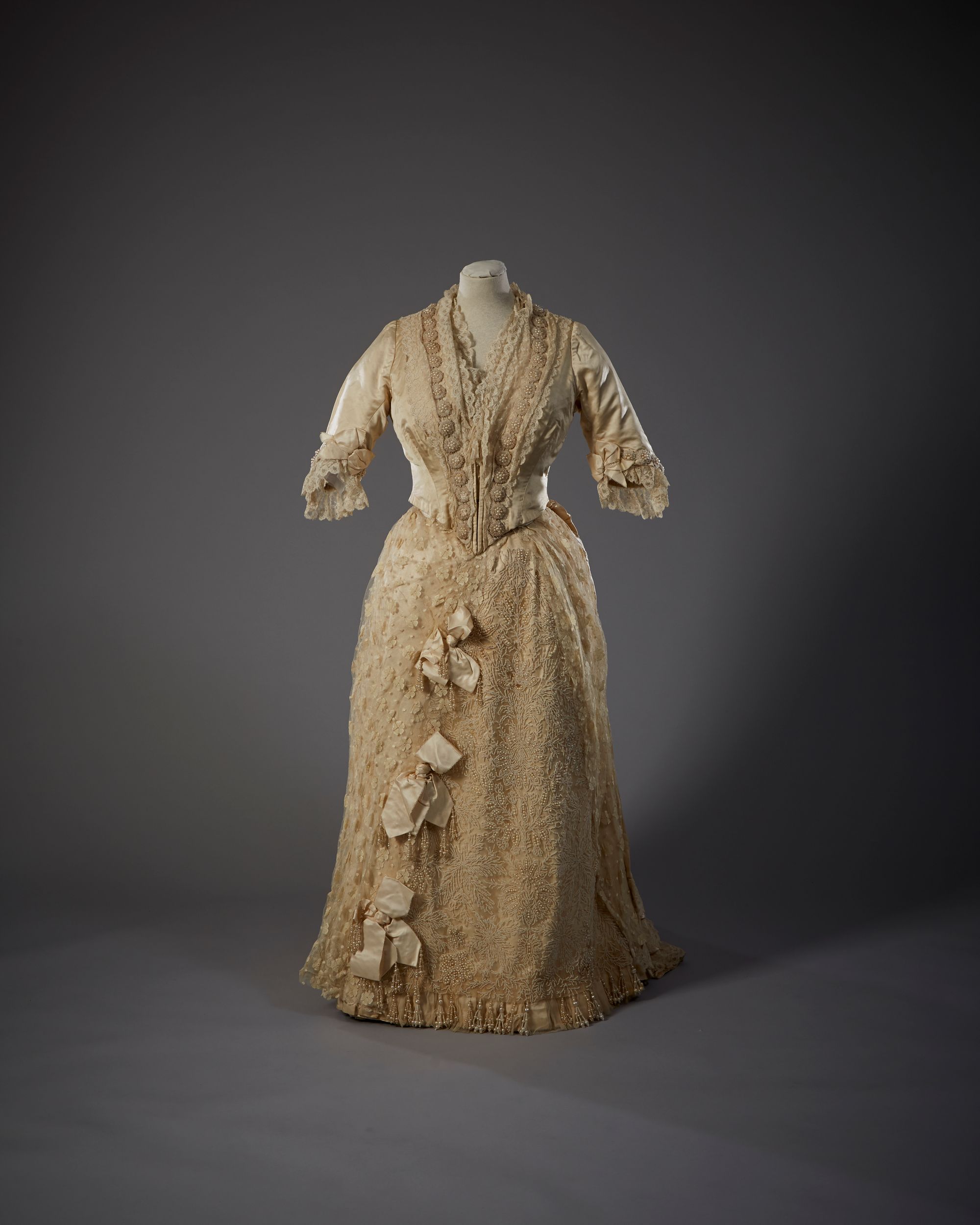
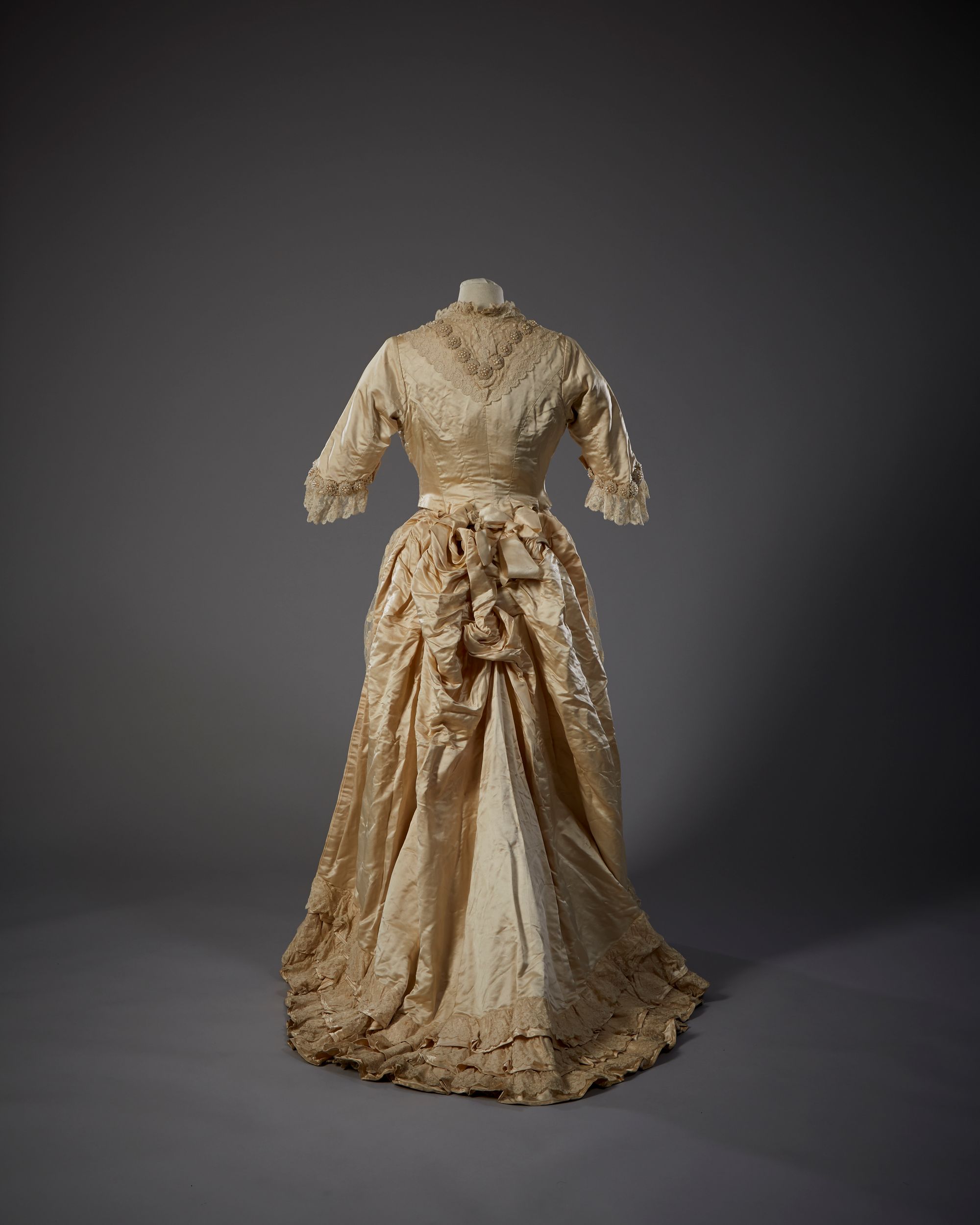
The Dress
c. 1892
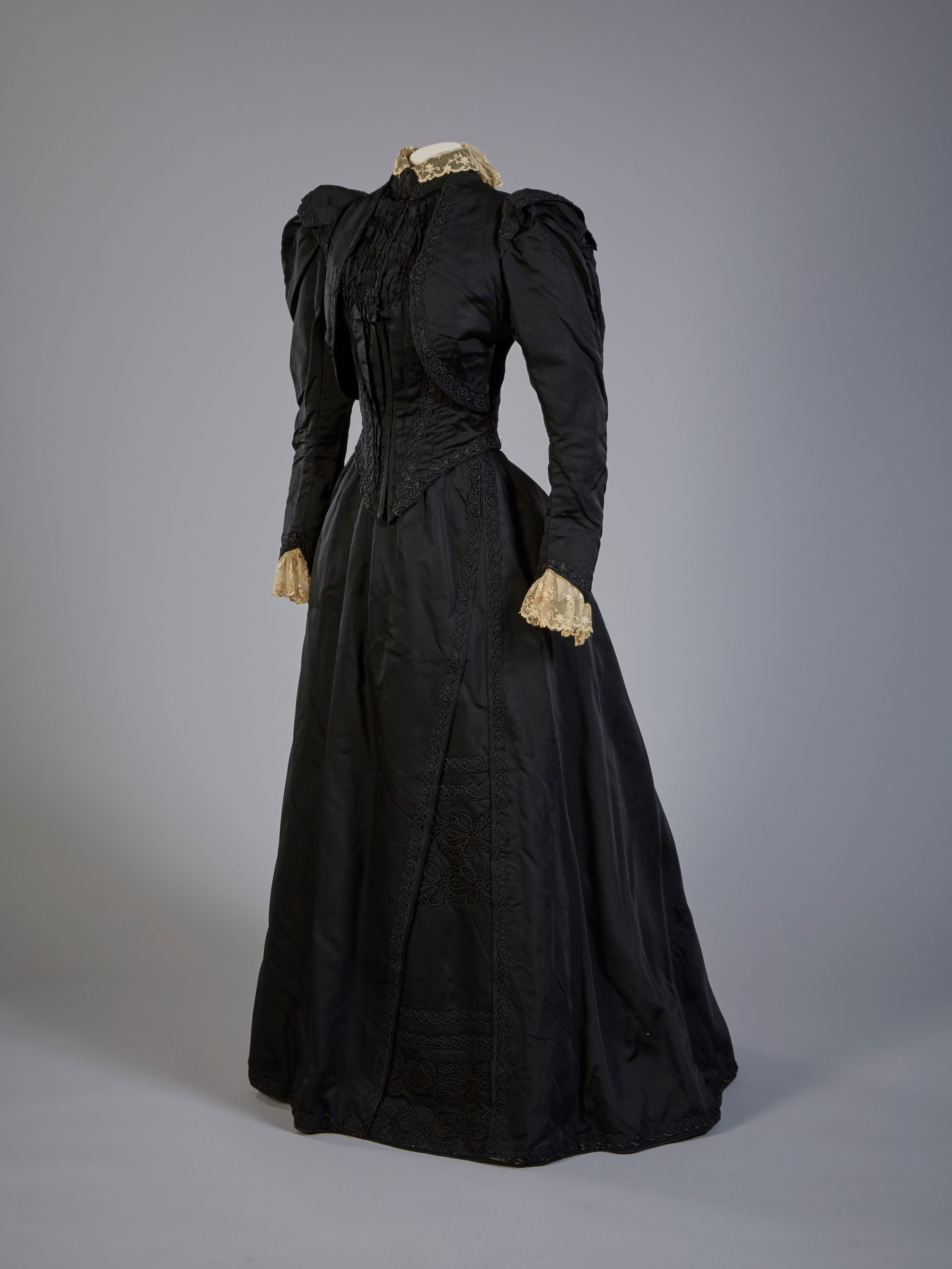
Mourning during the reign of Queen Victoria and her son Edward followed very strict rules. Widows were expected to wear mourning clothing for up to four years after their husband’s passing and parents for as long as they felt so disposed. Those subjected to these rules were allowed to slowly re-introduce conventional clothing at specific stages known as full mourning, half mourning and so on. These were identified by the introduction of specific jewellery, trimmings or muted colour. Even so, mourning attire could still follow the changes of fashion.
By the end of the century, styles were simplified and references to more historic designs started slowly appearing. The ‘leg o' mutton’ sleeve with the fuller top referencing late medieval and early renaissance style became very popular, as did the elongated bodice.
Bride-to-be Jane Livingstone wore this outfit to her wedding in 1892. From the introduction of black braid and white lace we can conclude that she was observing half mourning. The caps at the top of the sleeves also testify to her very fashionable taste, with their historical influences being the latest fashion.
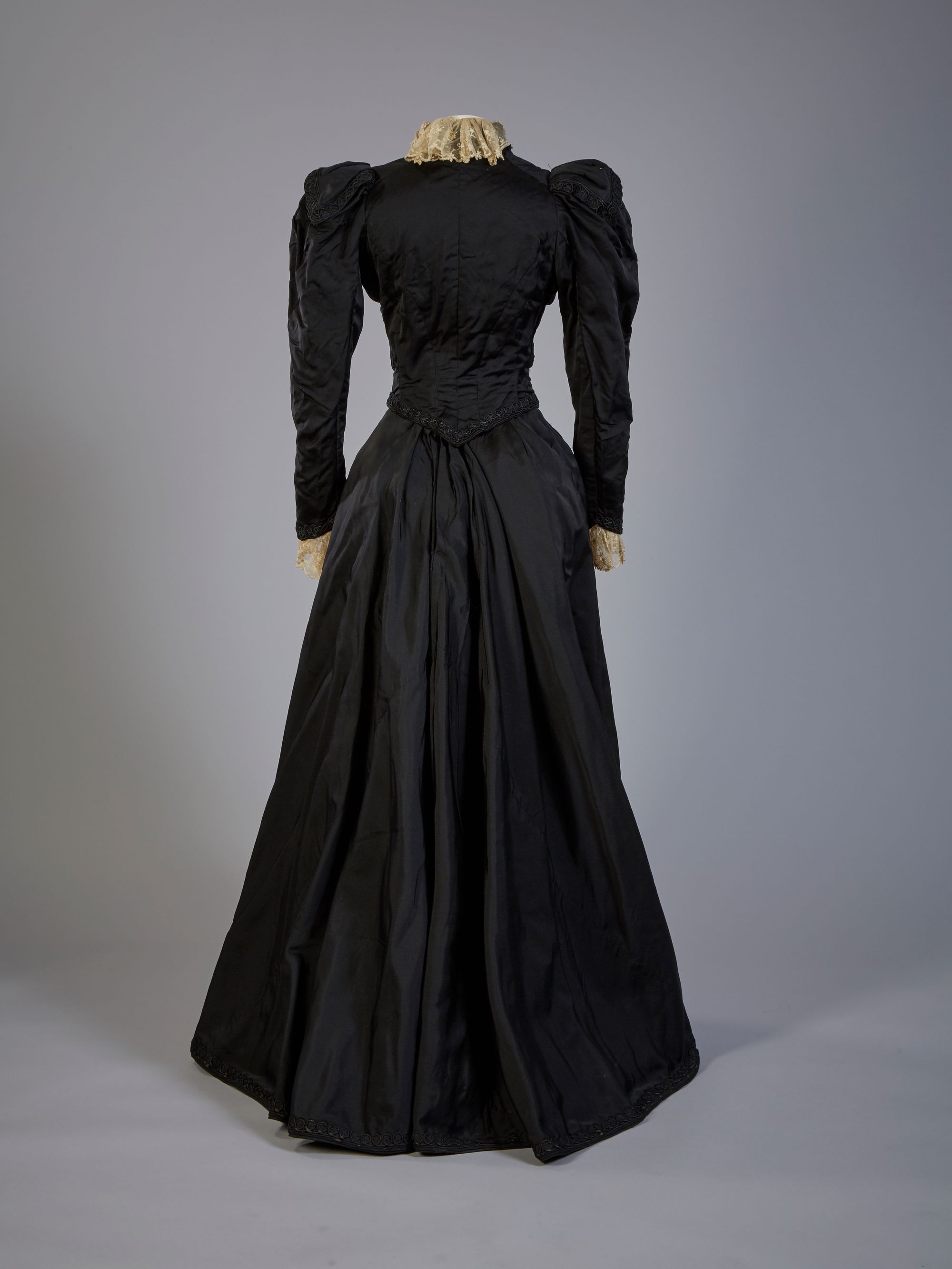
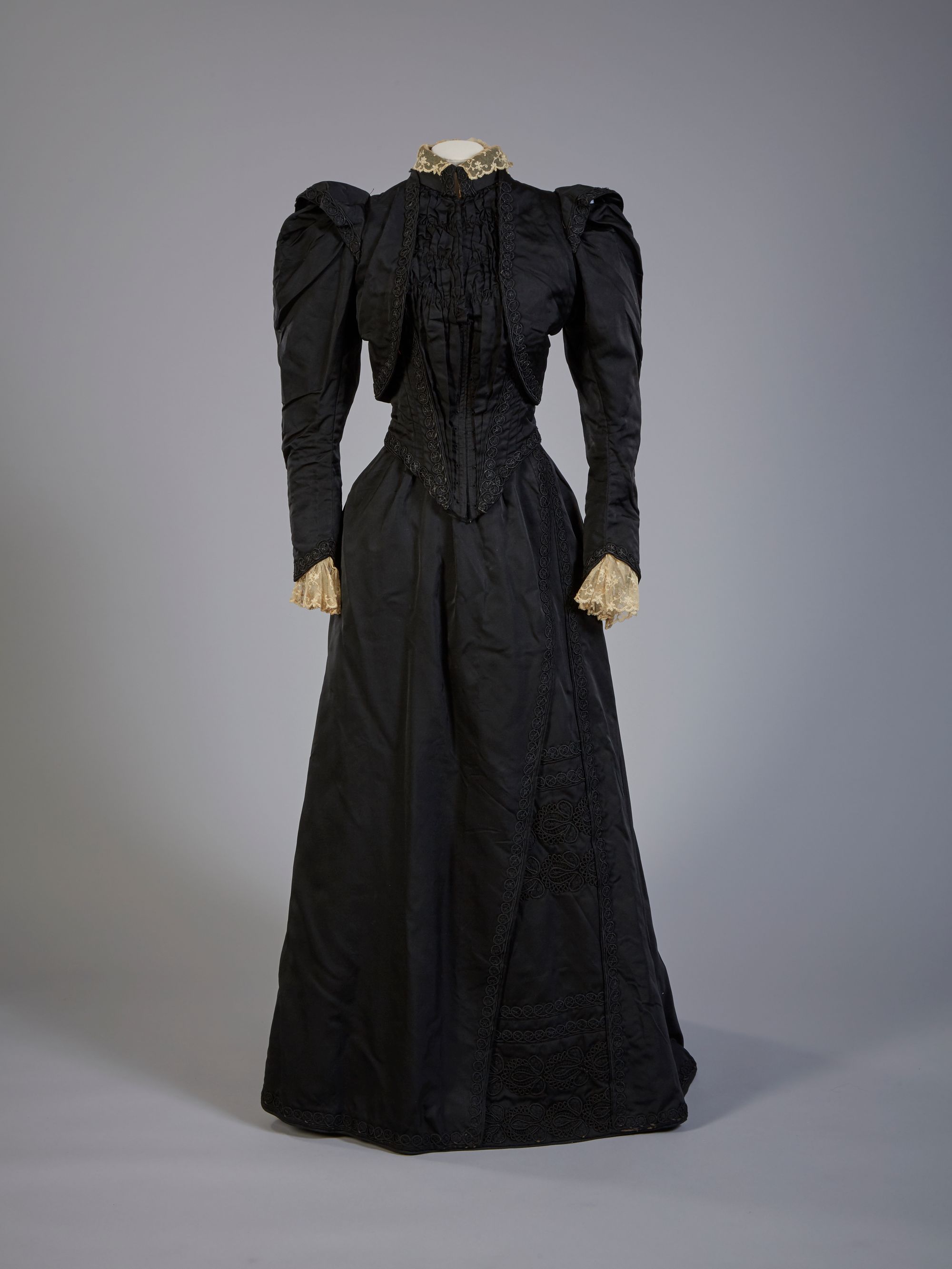
Part 2 will be published on 22 May 2020.
If you have enjoyed Culture on Call and you are able to make a donation, any support you can give will help us keep people connected.


